Compounds comprising triazine group, fluorene-group and hetero-fluorene group
Schulze , et al. A
U.S. patent number 10,741,770 [Application Number 16/184,556] was granted by the patent office on 2020-08-11 for compounds comprising triazine group, fluorene-group and hetero-fluorene group. This patent grant is currently assigned to Novaled GmbH, Samsung SDI Co., Ltd.. The grantee listed for this patent is Novaled GmbH, Samsung SDI Co., Ltd.. Invention is credited to Qiang Huang, Kipo Jang, Jinhyun Lui, Benjamin Schulze.

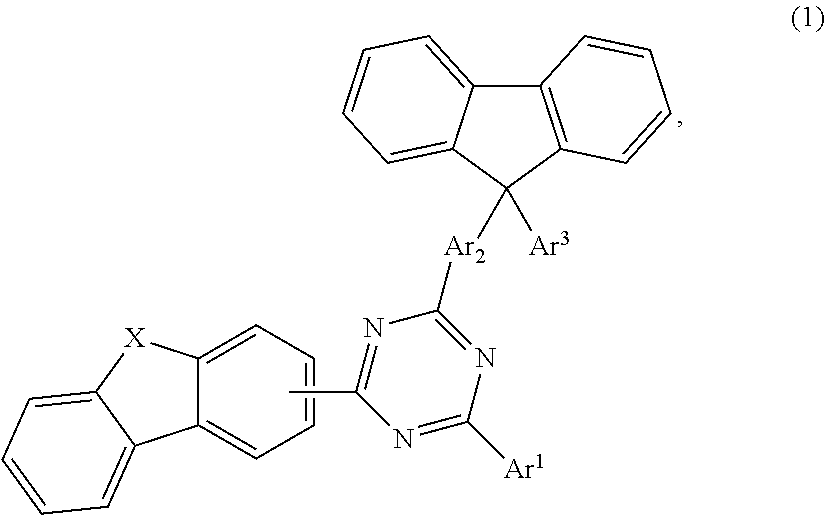
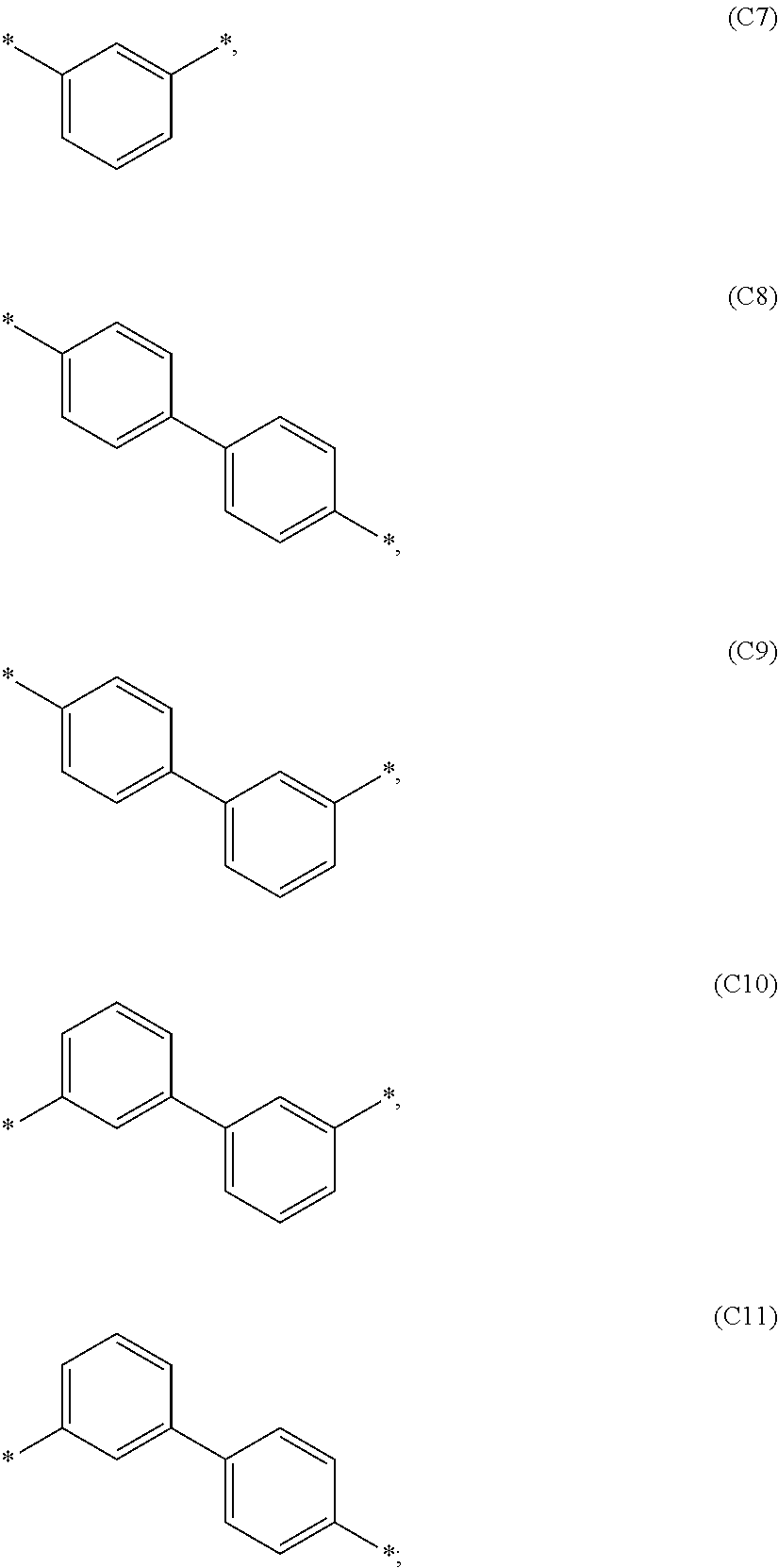




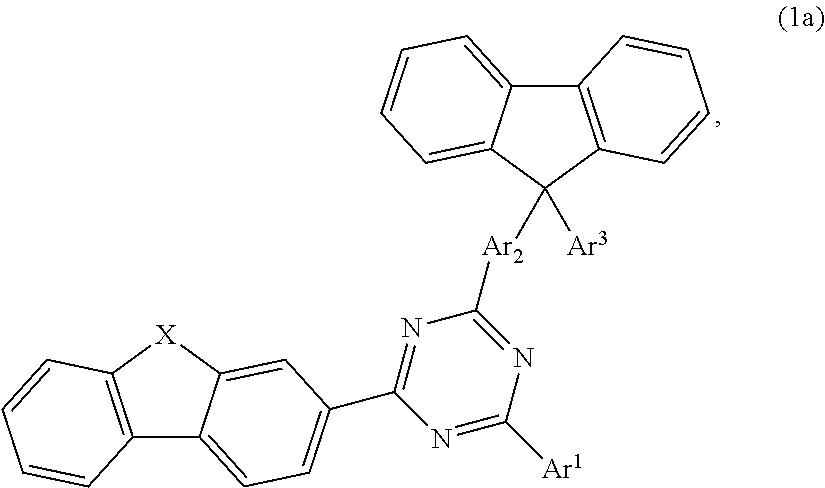



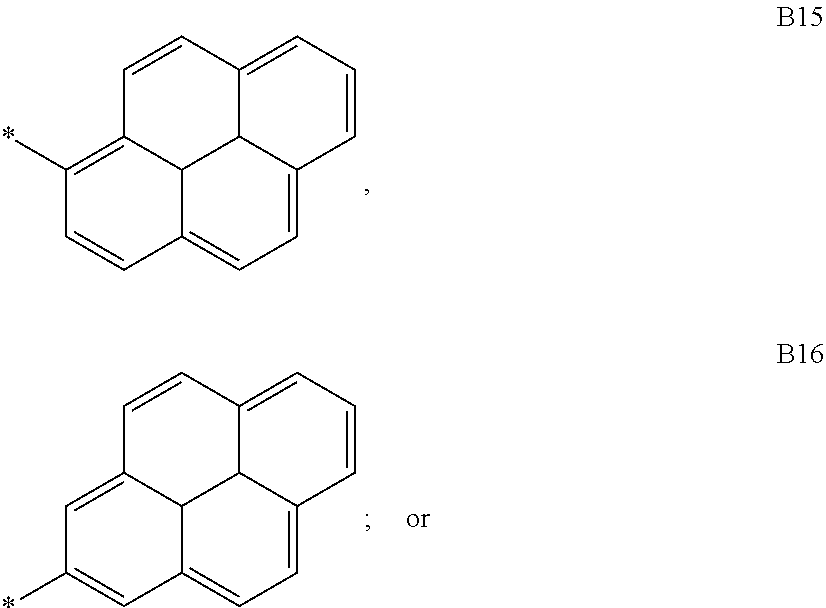
View All Diagrams
| United States Patent | 10,741,770 |
| Schulze , et al. | August 11, 2020 |
Compounds comprising triazine group, fluorene-group and hetero-fluorene group
Abstract
The present invention relates to a compound according to formula 1: ##STR00001## suitable for use as a layer material for electronic devices, and to an organic semiconductor layer comprising at least one compound according to formula 1, as well as to an organic electronic device comprising at least one organic semiconductor layer, and a method of manufacturing the same.
| Inventors: | Schulze; Benjamin (Dresden, DE), Huang; Qiang (Dresden, DE), Jang; Kipo (Gyeonggi-do, KR), Lui; Jinhyun (Gyeonggi-do, KR) | ||||||||||
|---|---|---|---|---|---|---|---|---|---|---|---|
| Applicant: |
|
||||||||||
| Assignee: | Novaled GmbH (Dresden,
DE) Samsung SDI Co., Ltd. (Gyeonggi-do, KR) |
||||||||||
| Family ID: | 60421564 | ||||||||||
| Appl. No.: | 16/184,556 | ||||||||||
| Filed: | November 8, 2018 |
Prior Publication Data
| Document Identifier | Publication Date | |
|---|---|---|
| US 20190140187 A1 | May 9, 2019 | |
Foreign Application Priority Data
| Nov 9, 2017 [EP] | 17200894 | |||
| Current U.S. Class: | 1/1 |
| Current CPC Class: | C09K 11/06 (20130101); C07D 405/04 (20130101); H01L 51/0052 (20130101); H01L 51/0067 (20130101); H01L 51/0073 (20130101); C09K 2211/1018 (20130101); Y02E 10/549 (20130101) |
| Current International Class: | H01L 51/00 (20060101); C07D 403/00 (20060101); C09K 11/06 (20060101); C07D 405/04 (20060101) |
References Cited [Referenced By]
U.S. Patent Documents
| 2012/0056171 | March 2012 | Kim |
| 106478609 | Mar 2019 | CN | |||
| 20150039673 | Apr 2015 | KR | |||
| 2017/171376 | Oct 2017 | WO | |||
Other References
|
European Search Report for EP Application No. 17200894.8 dated Feb. 19, 2018 (6 pages). cited by applicant. |
Primary Examiner: Nguyen; Haidung D
Attorney, Agent or Firm: Eversheds Sutherland (US) LLP
Claims
The invention claimed is:
1. A compound of formula 1, ##STR00043## wherein X is selected from O or S; Ar.sup.1 is selected from C.sub.1 to C.sub.16 alkyl or substituted or unsubstituted C.sub.6 to C.sub.24 aryl; Ar.sup.2 is selected from C.sub.1 to C.sub.16 alkylene or is selected from unsubstituted arylene (C7) to (C11): ##STR00044## Ar.sup.3 is selected from C.sub.1 to C.sub.16 alkyl, substituted or unsubstituted C.sub.6 to C.sub.36 aryl or substituted or unsubstituted C.sub.3 to C.sub.36 heteroaryl; and wherein Ar.sup.1 of substituted C.sub.6 to C.sub.24 aryl is mono or di-substituted, wherein the substituents of the substituted C.sub.6 to C.sub.24 aryl is selected from C.sub.1 to C.sub.16 alkyl, C.sub.6 to C.sub.18 aryl; and wherein Ar.sup.3 of substituted C.sub.6 to C.sub.36 aryl and Ar.sup.3 of substituted C.sub.3 to C.sub.36 heteroaryl is mono or di-substituted, wherein the substituents of the substituted C.sub.6 to C.sub.36 aryl and substituted C.sub.3 to C.sub.36 heteroaryl are selected from C.sub.1 to C.sub.16 alkyl, C.sub.1 to C.sub.16 alkoxy, partially or perfluorinated C.sub.1 to C.sub.16 alkyl, partially or perfluorinated C.sub.1 to C.sub.16 alkoxy, C.sub.6 to C.sub.18 aryl, C.sub.3 to C.sub.25 heteroaryl, F or CN.
2. The compound of formula 1 according to claim 1 having the formula 1a: ##STR00045##
3. The compound of formula 1 according to claim 1 having the formula 1b: ##STR00046##
4. The compound of formula 1 according to claim 1 having the formula 1c: ##STR00047##
5. The compound of formula 1 according to claim 1, wherein Ar.sup.1 is substituted or unsubstituted C.sub.6 to C.sub.12 aryl, wherein the substituents of the substituted C.sub.6 to C.sub.12 aryl is selected from C.sub.1 to C.sub.10 alkyl.
6. The compound of formula 1 according to claim 1, wherein Ar.sup.3 is selected from substituted or unsubstituted C.sub.6 to C.sub.24 aryl, wherein the substituents of the substituted C.sub.6 to C.sub.24 aryl are selected from C.sub.1 to C.sub.10 alkyl or CN.
7. The compound of formula 1 according to claim 1, wherein Ar.sup.1 is selected from substituted or unsubstituted annelated C.sub.6 to C.sub.24 aryl, wherein the substituents of the substituted annelated C.sub.6 to C.sub.24 aryl is selected from C.sub.1 to C.sub.16 alkyl, C.sub.6 to C.sub.18 aryl.
8. The compound of formula 1 according to claim 1, wherein Ar.sup.3 is selected from unsubstituted C.sub.6 to C.sub.24 aryl; and Ar.sup.1 is selected from unsubstituted C.sub.6 to C.sub.24 aryl or C.sub.1 to C.sub.16 alkyl substituted C.sub.6 to C.sub.24 aryl.
9. The compound of formula 1 according to claim 1, wherein Ar.sup.1 is independently selected from B1 to B16 and A.sup.3 is independently selected from B1 to B53: wherein a) B1 to B6 are substituted or unsubstituted non-heteroaryl groups: ##STR00048## b) B7 to B16 are substituted or unsubstituted annelated non-heteroaryl groups: ##STR00049## ##STR00050## c) B17 to B25 are dibenzofurane/dibenzothiophene group: ##STR00051## d) B26 to B28 are unsubstituted pyridine groups: ##STR00052## e) B29 to B46 are unsubstituted or substituted hetero arylene groups: ##STR00053## ##STR00054## f) B47 to B48 unsubstituted annelated hetero arylene groups: ##STR00055## g) B49 and B50 are nitrile substituted phenyl groups ##STR00056## h) B51 to B53 are nitrile substituted biphenyl groups ##STR00057## wherein the substituent R.sup.2 is independently selected from H, C.sub.1 to C.sub.16 alkyl, C.sub.6 to C.sub.18 aryl.
10. The compound of formula 1 according to claim 1, wherein Ar.sup.2 is selected from unsubstituted arylene (C7).
11. The compound of formula 1 according to claim 1, wherein the compound is selected from D1 to D11: ##STR00058## ##STR00059## ##STR00060## ##STR00061##
12. An organic semiconductor layer comprising at least one compound of formula 1 according to claim 1.
13. The organic semiconductor layer according to claim 12, further comprises a metal, metal salt or organic alkali metal complex.
14. An organic electronic device comprising an organic semiconductor layer according to claim 12, wherein at least one organic semiconductor layer comprises a compound selected from formula 1, 1a, 1b or 1c.
15. The organic electronic device according to claim 14, wherein the electronic device is selected from a light emitting device, thin film transistor, a battery, a display device or a photovoltaic cell.
Description
CROSS REFERENCE TO RELATED APPLICATION
This application claims priority to European Patent Application No. 17200894.8, filed Nov. 9, 2017, which is incorporated herein by reference.
TECHNICAL FIELD
The present invention relates to compounds, in particular to compounds with a triazine group, fluorene group and hetero-fluorene group, suitable for use as a layer material for electronic devices, and to an organic semiconductor layer comprising at least one compound thereof, as well as to an organic electronic device comprising at least one organic semiconductor layer, and a method of manufacturing the same.
BACKGROUND ART
Organic electronic devices, such as organic light-emitting diodes OLEDs, which are self-emitting devices, have a wide viewing angle, excellent contrast, quick response, high brightness, excellent operating voltage characteristics, and color reproduction. A typical OLED comprises an anode, a hole transport layer HTL, an emission layer EML, an electron transport layer ETL, and a cathode, which are sequentially stacked on a substrate. In this regard, the HTL, the EML, and the ETL are thin films formed from organic compounds.
When a voltage is applied to the anode and the cathode, holes injected from the anode move to the EML, via the HTL, and electrons injected from the cathode move to the EML, via the ETL. The holes and electrons recombine in the EML to generate excitons. When the excitons drop from an excited state to a ground state, light is emitted. The injection and flow of holes and electrons should be balanced, so that an OLED having the above-described structure has excellent efficiency and/or a long lifetime.
Performance of an organic light emitting diode may be affected by characteristics of the organic semiconductor layer, and among them, may be affected by characteristics of an organic material of the organic semiconductor layer.
Particularly, development for an organic material being capable of increasing electron mobility and simultaneously increasing electrochemical stability is needed so that the organic electronic device, such as an organic light emitting diode, may be applied to a large-size flat panel display.
WO2017171376 relates to a compound of the chemical formula 1 and an organic electronic element comprising the compound.
There remains a need to improve performance of organic semiconductor layers, organic semiconductor materials, as well as organic electronic devices thereof, in particular to achieve increased lifetime and higher efficiency through improving the characteristics of the compounds comprised therein.
There is a need for alternative organic semiconductor materials and organic semiconductor layers as well as organic electronic devices having increased lifetime and/or improved efficiency at low operating voltage.
In particular there is a need for alternative compounds having increased lifetime as well as improved efficiency and at the same time keeping the operating voltage and thereby the power consumption low to deliver long battery life for example mobile electronic devices.
DISCLOSURE
An aspect of the present invention provides a compound of formula 1,
##STR00002## wherein X is selected from O or S; Ar.sup.1 is selected from C.sub.1 to C.sub.16 alkyl, substituted or unsubstituted C.sub.6 to C.sub.24 aryl or substituted or unsubstituted C.sub.3 to C.sub.36 heteroaryl; Ar.sup.2 is selected from C.sub.1 to C.sub.16 alkylene or is selected from unsubstituted arylene (C7) to (C11):
##STR00003## Ar.sup.3 is selected from C.sub.1 to C.sub.16 alkyl, substituted or unsubstituted C.sub.6 to C.sub.36 aryl or substituted or unsubstituted C.sub.3 to C.sub.36 heteroaryl; and wherein Ar.sup.1 of substituted C.sub.6 to C.sub.24 aryl or Ar.sup.1 of substituted C.sub.3 to C.sub.36 heteroaryl is mono or di-substituted, wherein the substituents of the substituted C.sub.6 to C.sub.24 aryl and substituted C.sub.3 to C.sub.36 heteroaryl are selected from C.sub.1 to C.sub.16 alkyl, C.sub.1 to C.sub.16 alkoxy, partially or perfluorinated C.sub.1 to C.sub.16 alkyl, partially or perfluorinated C.sub.1 to C.sub.16 alkoxy, C.sub.6 to C.sub.18 aryl, C.sub.3 to C.sub.25 heteroaryl, F or CN; and wherein Ar.sup.3 of substituted C.sub.6 to C.sub.36 aryl and Ar.sup.3 of substituted C.sub.3 to C.sub.36 heteroaryl is mono or di-substituted, wherein the substituents of the substituted C.sub.6 to C.sub.36 aryl and substituted C.sub.3 to C.sub.36 heteroaryl are selected from C.sub.1 to C.sub.16 alkyl, C.sub.1 to C.sub.16 alkoxy, partially or perfluorinated C.sub.1 to C.sub.16 alkyl, partially or perfluorinated C.sub.1 to C.sub.16 alkoxy, C.sub.6 to C.sub.18 aryl, C.sub.3 to C.sub.25 heteroaryl, F or CN
According to another embodiment a compound of formula 1, is provided
##STR00004## wherein X is selected from O or S; Ar.sup.1 is selected from C.sub.1 to C.sub.16 alkyl, substituted or unsubstituted C.sub.6 to C.sub.24 aryl or substituted or unsubstituted C.sub.3 to C.sub.36 heteroaryl; Ar.sup.2 is selected from C.sub.1 to C.sub.16 alkylene, substituted or unsubstituted C.sub.6 to C.sub.36 arylene; Ar.sup.3 is selected from C.sub.1 to C.sub.16 alkyl, substituted or unsubstituted C.sub.6 to C.sub.36 aryl or substituted or unsubstituted C.sub.3 to C.sub.36 heteroaryl; and wherein substituted C.sub.6 to C.sub.24 aryl of Ar.sup.1 or substituted C.sub.3 to C.sub.36 heteroaryl of Ar.sup.1 is mono or di-substituted; and wherein substituted C.sub.6 to C.sub.36 aryl of Ar.sup.3 or substituted C.sub.3 to C.sub.36 heteroaryl of Ar.sup.3 is mono or di-substituted.
According to another embodiment of the compound of formula 1, wherein X can be selected from O or S, preferably O; Ar.sup.1 can be selected from C.sub.1 to C.sub.16 alkyl, substituted or unsubstituted C.sub.6 to C.sub.24 aryl or substituted or unsubstituted C.sub.3 to C.sub.36 heteroaryl, wherein the substituents of the substituted C.sub.6 to C.sub.24 aryl and substituted C.sub.3 to C.sub.36 heteroaryl are selected from C.sub.1 to C.sub.16 alkyl, C.sub.1 to C.sub.16 alkoxy, partially or perfluorinated C.sub.1 to C.sub.16 alkyl, partially or perfluorinated C.sub.1 to C.sub.16 alkoxy, C.sub.6 to C.sub.18 aryl, C.sub.3 to C.sub.25 heteroaryl, F or CN, preferably preferably from C.sub.1 to C.sub.16 alkyl; Ar.sup.2 can be selected from C.sub.1 to C.sub.16 alkylene, substituted or unsubstituted C.sub.6 to C.sub.36 arylene, wherein the substituents of the substituted C.sub.6 to C.sub.36 arylene are selected from C.sub.1 to C.sub.16 alkyl, C.sub.1 to C.sub.16 alkoxy, partially or perfluorinated C.sub.1 to C.sub.16 alkyl, partially or perfluorinated C.sub.1 to C.sub.16 alkoxy, F or CN, preferably from C.sub.1 to C.sub.16 alkyl; Ar.sup.3 can be selected from C.sub.1 to C.sub.16 alkyl, substituted or unsubstituted C.sub.6 to C.sub.36 aryl or substituted or unsubstituted C.sub.3 to C.sub.36 heteroaryl, wherein the substituents of the substituted C.sub.6 to C.sub.36 arylene and substituted C.sub.3 to C.sub.36 heteroarylene are selected from C.sub.1 to C.sub.16 alkyl, C.sub.1 to C.sub.16 alkoxy, partially or perfluorinated C.sub.1 to C.sub.16 alkyl, partially or perfluorinated C.sub.1 to C.sub.16 alkoxy, C.sub.6 to C.sub.18 aryl, C.sub.3 to C.sub.25 heteroaryl, F or CN, preferably from C.sub.1 to C.sub.16 alkyl; wherein substituted Ar.sup.1 and/or Ar.sup.3 is mono or di-substituted.
The Ar.sup.1 group is connected via a single bond to the triazine group of the compound of formula 1. Mono or di-substituted Ar.sup.1 means throughout the specification that for mono-substituted Ar.sup.1 the Ar.sup.1 group comprises one additional substituent and for di-substituted Ar.sup.1 the Ar.sup.1 group comprises two additional substituents, which can be independently selected.
The Ar.sup.3 group is connected via a single bond to a fluorene group of the compound of formula 1. Mono or di-substituted Ar.sup.3 means throughout the specification that for mono-substituted Ar.sup.3 the Ar.sup.3 group comprises one additional substituent and for di-substituted Ar.sup.3 the Ar.sup.3 group comprises two additional substituents, which can be independently selected.
Hetero atoms if not otherwise stated can be individually selected from N, O, S, B, Si, P, Se, preferably from N, O and S and more preferred is N.
According to one embodiment the compound is represented by formula 1, wherein Ar.sup.2 selected from carbazolylene is excluded.
According to one embodiment the compound of formula 1,
##STR00005## can be further defined, wherein X can be selected from O or S; Ar.sup.1 can be selected from C.sub.1 to C.sub.16 alkyl, substituted or unsubstituted C.sub.6 to C.sub.24 aryl or substituted or unsubstituted C.sub.3 to C.sub.36 heteroaryl, wherein the substituents of the substituted C.sub.6 to C.sub.24 aryl and substituted C.sub.3 to C.sub.36 heteroaryl are selected from C.sub.1 to C.sub.16 alkyl, C.sub.6 to C.sub.18 aryl, C.sub.3 to C.sub.25 heteroaryl or CN; Ar.sup.2 can be selected from C.sub.1 to C.sub.16 alkylene, substituted or unsubstituted C.sub.6 to C.sub.36 arylene, wherein the substituents of the substituted C.sub.6 to C.sub.36 arylene are selected from C.sub.1 to C.sub.16 alkyl or CN; Ar.sup.3 can be selected from C.sub.1 to C.sub.16 alkyl, substituted or unsubstituted C.sub.6 to C.sub.36 aryl or substituted or unsubstituted C.sub.3 to C.sub.36 heteroaryl, wherein the substituents of the substituted C.sub.6 to C.sub.36 aryl and substituted C.sub.3 to C.sub.36 heteroaryl are selected from C.sub.1 to C.sub.16 alkyl, C.sub.6 to C.sub.18 aryl, C.sub.3 to C.sub.25 heteroaryl or CN; and wherein substituted C.sub.6 to C.sub.24 aryl of Ar.sup.1 or substituted C.sub.3 to C.sub.36 heteroaryl of Ar.sup.1 is mono or di-substituted; and wherein substituted C.sub.6 to C.sub.36 aryl of Ar.sup.3 or substituted C.sub.3 to C.sub.36 heteroaryl of Ar.sup.3 is mono or di-substituted.
According to another embodiment of the compound of formula 1,
##STR00006## wherein X is selected from O or S, preferably O; Ar.sup.1 is selected from unsubstituted C.sub.6 to C.sub.24 aryl or C.sub.1 to C.sub.16 alkyl, substituted C.sub.6 to C.sub.24 aryl, preferably unsubstituted C.sub.6 to C.sub.18 aryl or C.sub.1 to C.sub.16 alkyl, substituted C.sub.6 to C.sub.18, and further preferred unsubstituted C.sub.12 to C.sub.18 aryl or C.sub.1 to C.sub.6 alkyl substituted C.sub.12 to C.sub.18, wherein the substituents of the substituted C.sub.6 to C.sub.24 aryl and substituted C.sub.3 to C.sub.36 heteroaryl are selected from C.sub.1 to C.sub.16 alkyl, C.sub.6 to C.sub.18 aryl, C.sub.3 to C.sub.25 heteroaryl or CN; Ar.sup.2 is selected from C.sub.1 to C.sub.16 alkylene, substituted or unsubstituted C.sub.6 to C.sub.36 arylene, preferably phenylene or biphenylene and more preferred phenylene, wherein the substituents of the substituted C.sub.6 to C.sub.36 arylene are selected from C.sub.1 to C.sub.16 alkyl or CN; Ar.sup.3 is selected from unsubstituted C.sub.6 to C.sub.24 aryl, preferably phenyl or biphenyl and in addition preferred phenyl, wherein the substituents of the substituted C.sub.6 to C.sub.36 aryl and substituted C.sub.3 to C.sub.36 heteroaryl are selected from C.sub.1 to C.sub.16 alkyl, C.sub.6 to C.sub.18 aryl, C.sub.3 to C.sub.25 heteroaryl or CN.
According to another embodiment of the compound of formula 1, wherein X can be selected from O or S; Ar.sup.1 can be selected from C.sub.1 to C.sub.16 alkyl, substituted or unsubstituted C.sub.6 to C.sub.24 aryl, wherein the substituents of the substituted C.sub.6 to C.sub.24 aryl are selected from C.sub.1 to C.sub.16 alkyl or C.sub.6 to C.sub.18 aryl; Ar.sup.2 can be selected from C.sub.1 to C.sub.16 alkylene, substituted or unsubstituted C.sub.6 to C.sub.36 arylene, wherein the substituents of the substituted C.sub.6 to C.sub.36 arylene are selected from C.sub.1 to C.sub.16 alkyl; Ar.sup.3 can be selected from C.sub.1 to C.sub.16 alkyl, substituted or unsubstituted C.sub.6 to C.sub.36 aryl, wherein the substituents of the substituted C.sub.6 to C.sub.36 aryl are selected from C.sub.1 to C.sub.16 alkyl, C.sub.6 to C.sub.18 aryl; wherein substituted Ar.sup.1 and/or Ar.sup.3 is mono or di-substituted.
According to another embodiment of the compound of formula 1, wherein X can be selected from O; Ar.sup.1 can be selected from C.sub.1 to C.sub.16 alkyl, substituted or unsubstituted C.sub.6 to C.sub.24 aryl or substituted or unsubstituted C.sub.3 to C.sub.36 heteroaryl, wherein the substituents of the substituted C.sub.6 to C.sub.24 aryl and substituted C.sub.3 to C.sub.36 heteroaryl are selected from C.sub.1 to C.sub.16 alkyl; Ar.sup.2 can be selected from C.sub.1 to C.sub.16 alkylene, substituted or unsubstituted C.sub.6 to C.sub.36 arylene, wherein the substituents of the substituted C.sub.6 to C.sub.36 arylene are selected from C.sub.1 to C.sub.16 alkyl; Ar.sup.3 can be selected from C.sub.1 to C.sub.16 alkyl, substituted or unsubstituted C.sub.6 to C.sub.36 aryl or substituted or unsubstituted C.sub.3 to C.sub.36 heteroaryl, wherein the substituents of the substituted C.sub.6 to C.sub.36 aryl and substituted C.sub.3 to C.sub.36 heteroaryl are selected from C.sub.1 to C.sub.16 alkyl; wherein substituted Ar.sup.1 and/or substituted Ar.sup.3 is mono or di-substituted.
According to another embodiment of the compound of formula 1, wherein X can be selected from O; Ar.sup.1 can be selected from C.sub.1 to C.sub.16 alkyl, substituted or unsubstituted C.sub.6 to C.sub.24 aryl or substituted or unsubstituted C.sub.3 to C.sub.36 heteroaryl, wherein the substituents of the substituted C.sub.6 to C.sub.24 aryl and substituted C.sub.3 to C.sub.36 heteroaryl are selected from C.sub.1 to C.sub.16 alkyl; Ar.sup.2 can be selected from C.sub.1 to C.sub.16 alkylene, substituted or unsubstituted C.sub.6 to C.sub.36 arylene, wherein the substituents of the substituted C.sub.6 to C.sub.36 arylene are selected from C.sub.1 to C.sub.16 alkyl; Ar.sup.3 can be selected from C.sub.1 to C.sub.16 alkyl, substituted or unsubstituted C.sub.6 to C.sub.36 aryl or substituted or unsubstituted C.sub.3 to C.sub.36 heteroaryl, wherein the substituents of the substituted C.sub.6 to C.sub.36 aryl and substituted C.sub.3 to C.sub.36 heteroaryl are selected from C.sub.1 to C.sub.16 alkyl; wherein substituted Ar.sup.1 and/or substituted Ar.sup.3 is mono-substituted.
According to another embodiment of the compound of formula 1, wherein X can be selected from O; Ar.sup.1 can be selected from unsubstituted C.sub.6 to C.sub.24 aryl or unsubstituted C.sub.6 to C.sub.24 heteroaryl; Ar.sup.2 can be selected from unsubstituted C.sub.6 to C.sub.36 arylene; Ar.sup.3 can be selected from unsubstituted C.sub.6 to C.sub.36 aryl or unsubstituted C.sub.6 to C.sub.36 heteroaryl.
According to another embodiment of the compound of formula 1, wherein X can be selected from O or S; Ar.sup.1 can be selected from unsubstituted C.sub.6 to C.sub.24 aryl or unsubstituted C.sub.6 to C.sub.24 heteroaryl; Ar.sup.2 can be selected from unsubstituted C.sub.6 to C.sub.36 arylene; Ar.sup.3 can be selected from unsubstituted C.sub.6 to C.sub.36 aryl or unsubstituted C.sub.6 to C.sub.36 heteroaryl.
According to another embodiment of the compound of formula 1, wherein X can be selected from O; Ar.sup.1 can be selected from unsubstituted C.sub.6 to C.sub.12 aryl or unsubstituted C.sub.6 to C.sub.12 heteroaryl; Ar.sup.2 can be selected from unsubstituted C.sub.6 to C.sub.24 arylene; Ar.sup.3 can be selected from unsubstituted C.sub.6 to C.sub.24 aryl or unsubstituted C.sub.6 to C.sub.24 heteroaryl.
According to another embodiment of the compound of formula 1, wherein X can be selected from S; Ar.sup.1 can be selected from unsubstituted C.sub.6 to C.sub.12 aryl or unsubstituted C.sub.6 to C.sub.12 heteroaryl; Ar.sup.2 can be selected from unsubstituted C.sub.6 to C.sub.24 arylene; Ar.sup.3 can be selected from unsubstituted C.sub.6 to C.sub.24 aryl or unsubstituted C.sub.6 to C.sub.24 heteroaryl.
According to another embodiment of the compound of formula 1, wherein X can be selected from O; Ar.sup.1 can be selected from unsubstituted C.sub.6 to C.sub.12 aryl or unsubstituted C.sub.6 to C.sub.12 heteroaryl; Ar.sup.2 can be selected from unsubstituted C.sub.6 arylene; Ar.sup.3 can be selected from unsubstituted C.sub.6 to C.sub.12 aryl or unsubstituted C.sub.6 to C.sub.12 heteroaryl.
According to another embodiment of the compound of formula 1, wherein X can be selected from S; Ar.sup.1 can be selected from unsubstituted C.sub.6 to C.sub.12 aryl or unsubstituted C.sub.6 to C.sub.12 heteroaryl; Ar.sup.2 can be selected from unsubstituted C.sub.6 arylene; Ar.sup.3 can be selected from unsubstituted C.sub.6 to C.sub.12 aryl or unsubstituted C.sub.6 to C.sub.12 heteroaryl.
According to another embodiment of the compound of formula 1, wherein X can be selected from O; Ar.sup.1 can be selected from unsubstituted C.sub.6 to C.sub.24 aryl; Ar.sup.2 can be selected from unsubstituted C.sub.6 to C.sub.36 arylene; Ar.sup.3 can be selected from unsubstituted C.sub.6 to C.sub.36 aryl.
According to another embodiment of the compound of formula 1, wherein X can be selected from S; Ar.sup.1 can be selected from unsubstituted C.sub.6 to C.sub.24 aryl; Ar.sup.2 can be selected from unsubstituted C.sub.6 to C.sub.36 arylene; Ar.sup.3 can be selected from unsubstituted C.sub.6 to C.sub.36 aryl.
According to another embodiment of the compound of formula 1, wherein X can be selected from O; Ar.sup.1 can be selected from unsubstituted C.sub.6 to C.sub.12 aryl; Ar.sup.2 can be selected from unsubstituted C.sub.6 to C.sub.24 arylene; Ar.sup.3 can be selected from unsubstituted C.sub.6 to C.sub.24 aryl.
According to another embodiment of the compound of formula 1, wherein X can be selected from S; Ar.sup.1 can be selected from unsubstituted C.sub.6 to C.sub.12 aryl; Ar.sup.2 can be selected from unsubstituted C.sub.6 to C.sub.24 arylene; Ar.sup.3 can be selected from unsubstituted C.sub.6 to C.sub.24 aryl.
According to another embodiment of the compound of formula 1, wherein X can be selected from O; Ar.sup.1 can be selected from unsubstituted C.sub.6 to C.sub.12 aryl; Ar.sup.2 can be selected from unsubstituted C.sub.6 to C.sub.12 arylene; Ar.sup.3 can be selected from unsubstituted C.sub.6 aryl.
According to another embodiment of the compound of formula 1, wherein X can be selected from S; Ar.sup.1 can be selected from unsubstituted C.sub.6 to C.sub.12 aryl; Ar.sup.2 can be selected from unsubstituted C.sub.6 to C.sub.12 arylene; Ar.sup.3 can be selected from unsubstituted C.sub.6 aryl.
According to another embodiment of the compound of formula 1, wherein X can be selected from O; Ar.sup.1 can be selected from unsubstituted C.sub.6 to C.sub.24 heteroaryl; Ar.sup.2 can be selected from unsubstituted C.sub.6 to C.sub.36 arylene; Ar.sup.3 can be selected from unsubstituted C.sub.6 to C.sub.36 heteroaryl.
According to another embodiment of the compound of formula 1, wherein X can be selected from S; Ar.sup.1 can be selected from unsubstituted C.sub.6 to C.sub.24 heteroaryl; Ar.sup.2 can be selected from unsubstituted C.sub.6 to C.sub.36 arylene; Ar.sup.3 can be selected from unsubstituted C.sub.6 to C.sub.36 heteroaryl.
According to another embodiment of the compound of formula 1, wherein X can be selected from O; Ar.sup.1 can be selected from unsubstituted C.sub.6 to C.sub.12 heteroaryl; Ar.sup.2 can be selected from unsubstituted C.sub.6 to C.sub.24 arylene; Ar.sup.3 can be selected from unsubstituted C.sub.6 to C.sub.24 heteroaryl.
According to another embodiment of the compound of formula 1, wherein X can be selected from S; Ar.sup.1 can be selected from unsubstituted C.sub.6 to C.sub.12 heteroaryl; Ar.sup.2 can be selected from unsubstituted C.sub.6 to C.sub.24 arylene; Ar.sup.3 can be selected from unsubstituted C.sub.6 to C.sub.24 heteroaryl.
According to another embodiment of the compound of formula 1, wherein X can be selected from O; Ar.sup.1 can be selected from unsubstituted C.sub.6 to C.sub.12 heteroaryl; Ar.sup.2 can be selected from unsubstituted C.sub.6 to C.sub.12 arylene; Ar.sup.3 can be selected from unsubstituted C.sub.6 to C.sub.12 heteroaryl.
According to another embodiment of the compound of formula 1, wherein X can be selected from S; Ar.sup.1 can be selected from unsubstituted C.sub.6 to C.sub.12 heteroaryl; Ar.sup.2 can be selected from unsubstituted C.sub.6 to C.sub.12 arylene; Ar.sup.3 can be selected from unsubstituted C.sub.6 to C.sub.12 heteroaryl.
According to another embodiment, formula 1 may comprises at least about 5 to about 16 C.sub.6 aryl rings.
According to another embodiment, formula 1 may comprises at least about 5 to about 16 C.sub.6 aryl rings and at least about 1 to about 5 six-member hetero aryl rings, wherein at least one six-member hetero aryl ring is a triazine and the hetero atoms can be individually selected from N, O, S.
According to an aspect the compound of formula 1 can be used as a matrix material for a dopant material.
According to an aspect the layer material can be an organic semiconductor layer, which is used for an organic electronic device. For example, the organic electronic device can be an OLED or there like.
The compounds represented by formula 1 have strong electron transport characteristics to increase charge mobility and/or stability and thereby to improve luminance efficiency, voltage characteristics, and/or lifetime characteristics.
The compounds represented by formula 1 have high electron mobility and a low operating voltage.
The compounds represented by formula 1 and an organic semiconductor layer consisting or comprising of a compound of formula 1 may be non-emissive.
In the context of the present specification the term "essentially non-emissive" or "non-emitting" means that the contribution of the compound or layer to the visible emission spectrum from the device is less than 10%, preferably less than 5% relative to the visible emission spectrum. The visible emission spectrum is an emission spectrum with a wavelength of about .gtoreq.380 nm to about <780 nm.
Preferably, the organic semiconductor layer comprising the compound of formula 1 is essentially non-emissive or non-emitting.
The term "free of", "does not contain", "does not comprise" does not exclude impurities which may be present in the compounds prior to deposition. Impurities have no technical effect with respect to the object achieved by the present invention.
The operating voltage, also named U, is measured in Volt (V) at 10 milliAmpere per square centimeter (mA/cm2).
The candela per Ampere efficiency, also named cd/A efficiency, is measured in candela per ampere at 10 milliAmpere per square centimeter (mA/cm2).
The external quantum efficiency, also named EQE, is measured in percent (%).
The color space is described by coordinates CIE-x and CIE-y (International Commission on Illumination 1931). For blue emission the CIE-y is of particular importance. A smaller CIE-y denotes a deeper blue color.
The highest occupied molecular orbital, also named HOMO, and lowest unoccupied molecular orbital, also named LUMO, are measured in electron volt (eV).
The term "OLED", "organic light emitting diode", "organic light emitting device", "organic optoelectronic device" and "organic light-emitting diode" are simultaneously used and have the same meaning.
The term "transition metal" means and comprises any element in the d-block of the periodic table, which comprises groups 3 to 12 elements on the periodic table.
The term "group III to VI metal" means and comprises any metal in groups III to VI of the periodic table.
As used herein, "weight percent", "wt.-%", "percent by weight", "% by weight", and variations thereof refer to a composition, component, substance or agent as the weight of that composition, component, substance or agent of the respective electron transport layer divided by the total weight of the composition thereof and multiplied by 100. It is understood that the total weight percent amount of all components, substances or agents of the respective electron transport layer are selected such that it does not exceed 100 wt.-%.
As used herein, "volume percent", "vol.-%", "percent by volume", "% by volume", and variations thereof refer to an elemental metal, a composition, component, substance or agent as the volume of that elemental metal, component, substance or agent of the respective electron transport layer divided by the total volume of the respective electron transport layer thereof and multiplied by 100. It is understood that the total volume percent amount of all elemental metal, components, substances or agents of the respective cathode electrode layer are selected such that it does not exceed 100 vol.-%.
All numeric values are herein assumed to be modified by the term "about", whether or not explicitly indicated. As used herein, the term "about" refers to variation in the numerical quantity that can occur.
Whether or not modified by the term "about", the claims include equivalents to the quantities.
It should be noted that, as used in this specification and the appended claims, the singular forms "a", "an", and "the" include plural referents unless the content clearly dictates otherwise.
It should be noted that, as used in this specification and the appended claims, "*" if not otherwise defined indicates the chemical bonding position.
The anode electrode and cathode electrode may be described as anode electrode/cathode electrode or anode electrode/cathode electrode or anode electrode layer/cathode electrode layer.
According to another aspect, an organic optoelectronic device comprises an anode layer and a cathode layer facing each other and at least one organic semiconductor layer between the anode layer and the cathode layer, wherein the organic semiconductor layer comprises or consists of the compound of formula 1.
According to yet another aspect, a display device comprising the organic electronic device, which can be an organic optoelectronic device, is provided.
In the present specification, when a definition is not otherwise provided, an "alkyl group" may refer to an aliphatic hydrocarbon group. The alkyl group may refer to "a saturated alkyl group" without any double bond or triple bond. The alkyl group may be a linear, cyclic or branched alkyl group.
The alkyl group may be a C.sub.1 to C.sub.16 alkyl group, or preferably a C.sub.1 to C.sub.12 alkyl group. More specifically, the alkyl group may be a C.sub.1 to C.sub.14 alkyl group, or preferably a C.sub.1 to C.sub.10 alkyl group or a C.sub.1 to C.sub.6 alkyl group. For example, a C.sub.1 to C.sub.4 alkyl group comprises 1 to 4 carbons in alkyl chain, and may be selected from methyl, ethyl, propyl, iso-propyl, n-butyl, iso-butyl, sec-butyl, and t-butyl.
Specific examples of the alkyl group may be a methyl group, an ethyl group, a propyl group, an isopropyl group, a butyl group, an isobutyl group, a tert-butyl group, a pentyl group, a hexyl group, a cyclopropyl group, a cyclobutyl group, a cyclopentyl group, a cyclohexyl group, and the like.
In the present specification, when a definition is not otherwise provided, R.sup.2 can be independently selected from H, C.sub.1 to C.sub.16 alkyl, C.sub.6 to C.sub.18 aryl.
In the present specification "arylene group" may refer to a group comprising at least one hydrocarbon aromatic moiety, and all the elements of the hydrocarbon aromatic moiety may have p-orbitals which form conjugation, for example a phenyl group, a naphtyl group, an anthracenyl group, a phenanthrenyl group, a pyrenyl group, a fluorenyl group and the like.
The arylene group may include a monocyclic, polycyclic or fused ring polycyclic (i.e., rings sharing adjacent pairs of carbon atoms) functional group.
The term "heteroarylene" may refer to aromatic heterocycles with at least one heteroatom, and all the elements of the hydrocarbon heteroaromatic moiety may have p-orbitals which form conjugation. The heteroatom may be selected from N, O, S, B, Si, P, Se, preferably from N, O and S.
A heteroarylene ring may comprise at least 1 to 3 heteroatoms. Preferably a heteroarylene ring may comprise at least 1 to 3 heteroatoms individually selected from N, S and/or 0.
Further preferred in addition to the triazine group of formula 1 at least one additional heteroaryl/ene ring may comprise at least 1 to 3 N-atoms, or at least 1 to 2-N atoms or at least one N-atom.
The term "heteroarylene" as used herewith shall encompass dibenzofurane, dibenzothiopene, pyridine, quinoline, quinazoline, pyrimidine, triazine, benzimidazole, benzothiazole, benzoxazole, benzo[4,5]thieno[3,2-d]pyrimidine, carbazole, xanthene, phenoxazine, benzoacridine, dibenzoacridine and the like.
In the present specification, the single bond refers to a direct bond.
In the present specification, when a definition is not otherwise provided, Ar.sup.1 can be independently selected from substituted or unsubstituted C.sub.6-C.sub.24 aryl or C.sub.3-C.sub.36 heteroaryl, wherein the substituents of C.sub.6-C.sub.24 aryl or C.sub.3-C.sub.36 heteroaryl are independently selected from linear C.sub.1-16 alkyl, branched C.sub.3-16 alkyl, CN.
Preferably Ar.sup.1 can be independently selected from substituted or unsubstituted C.sub.6-C.sub.18 aryl or C.sub.3-C.sub.17 heteroaryl, wherein the substituents of C.sub.6-C.sub.18 aryl or C.sub.3-C.sub.17 heteroaryl are independently selected from linear C.sub.1-16 alkyl, branched C.sub.3-10 alkyl, CN.
Further preferred, Ar.sup.1 can be independently selected from substituted or unsubstituted C.sub.6-C.sub.12 aryl or C.sub.4-C.sub.11 heteroaryl, wherein the substituents of C.sub.6-C.sub.12 aryl or C.sub.5-C.sub.11 heteroaryl are independently selected from linear C.sub.1-3 alkyl, branched C.sub.3-5 alkyl.
In addition preferred, Ar.sup.1 can be independently selected from unsubstituted C.sub.6-C.sub.12 aryl or C.sub.3-C.sub.11 heteroaryl, C.sub.4-C.sub.11 heteroaryl or C.sub.5-C.sub.11 heteroaryl.
In the present specification, when a definition is not otherwise provided, Ar.sup.2 can be independently selected from C.sub.1 to C.sub.16 alkylene, substituted or unsubstituted C.sub.6-36 arylene; wherein the substituents of the C.sub.6-36 arylene are independently selected from C.sub.1-C.sub.16 alkyl, CN.
According to another preferred embodiment the compound according to formula 1 may comprise: at least 7 to 25 aromatic rings, preferably at least 8 to 22 aromatic rings, further preferred at least 9 to 20 aromatic rings, in addition preferred at least 10 to 15 aromatic rings and more preferred at least 10 to 14 aromatic rings; wherein at least 2 to 5, preferably 3 to 4 or 2 to 3, are heteroaromatic rings.
According to one embodiment the compound according to formula 1: comprises at least about 8 to about 20 aromatic rings, preferably at least about 9 to about 18 aromatic rings, further preferred at least about 10 to about 16 aromatic rings, in addition preferred at least about 11 to about 15 aromatic rings and more preferred at least about 10 to about 14 aromatic rings; and/or the compound of formula 1 comprises at least about 2 to about 6, preferably about 3 to about 5 or about 2 to about 4, hetero aromatic rings, wherein the hetero atoms can be selected from N, O, S; and/or comprises at least one fluorene ring and at least one hetero-fluorene ring, wherein the hetero atoms can be selected from N, O, S; and/or comprises at least one triazine ring, and preferably at least two triazine rings.
According to one preferred embodiment the compound according to formula 1 may comprises at least about 8 to about 20 aromatic rings, preferably at least about 9 to 18 aromatic rings, further preferred at least 10 to about 16 aromatic rings, in addition preferred at least 8 to 15 aromatic rings and more preferred at least about 10 to about 14 aromatic rings, wherein at least one of the aromatic rings is an unsubstituted five member ring and at least one of the aromatic rings is a five member hetero-ring.
According to one preferred embodiment the compound according to formula 1 may comprises at least about 8 to about 20 aromatic rings, preferably at least about 9 to 18 aromatic rings, further preferred at least 10 to about 16 aromatic rings, in addition preferred at least 8 to 15 aromatic rings and more preferred at least about 10 to about 14 aromatic rings, wherein at least one of the aromatic rings is an unsubstituted five member ring and at least one of the aromatic rings is a five member hetero-ring.
According to a further preferred embodiment the compound of formula 1 comprises at least 2 to 7, preferably 2 to 5, or 2 to 3 hetero aromatic rings.
According to a further preferred embodiment the compound of formula 1 comprises at least 2 to 7, preferably 2 to 5, or 2 to 3 hetero aromatic rings, wherein at least one of the aromatic rings is a five member hetero aromatic ring.
According to a further preferred embodiment the compound of formula 1 comprises at least 3 to 7, preferably 3 to 6, or 3 to 5 hetero aromatic rings, wherein at least two of the hetero aromatic rings are five member hetero-aromatic-ring.
According to one embodiment the compound according to formula 1 may comprise at least 6 to 12 non-hetero aromatic rings and 2 to 3 hetero aromatic rings.
According to one preferred embodiment the compound according to formula 1 may comprise at least 7 to 12 non-hetero aromatic rings and 2 to 5 hetero aromatic rings.
According to one preferred embodiment the compound according to formula 1 may comprise at least 7 to 11 non-hetero aromatic rings and 2 to 3 hetero aromatic rings.
The term "C.sub.6-arylene ring" means single C.sub.6-arylene rings and C.sub.6-arylene rings which form condensed ring systems. For example, a naphthalene group would be counted as two C.sub.6-arylene rings.
According to another embodiment of formula 1, wherein for Ar.sup.1 and/or Ar.sup.3 at least one heteroarylene group is selected from dibenzofurane, dibenzothiophene, triazine, quinoline, quinazoline, benzimidazole, benzothiazole, benzoxazole, benzo[4,5]thieno[3,2-d]pyrimidine, acridine, benzoacridine, dibenzoacridine, pyrimidine and pyridine, and is preferably selected from pyridine, quinoline, dibenzofurane or dibenzothiophene.
According to another embodiment, Ar.sup.1 is selected from C.sub.1 to C.sub.16 alkyl, substituted or unsubstituted C.sub.6 to C.sub.24 aryl or substituted or unsubstituted C.sub.3 to C.sub.36 heteroaryl and Ar.sup.3 is selected from dibenzofurane, dibenzothiophene, triazine, quinoline, quinazoline, benzimidazole, benzothiazole, benzoxazole, benzo[4,5]thieno[3,2-d]pyrimidine, acridine, benzoacridine, dibenzoacridine, pyrimidine and is preferably selected from quinoline, dibenzofurane or dibenzothiophene.
According to another embodiment the compound of formula 1 may have a glass transition temperature Tg of about .gtoreq.115.degree. C. and about .ltoreq.380.degree. C., preferably about .gtoreq.120.degree. C. and about .ltoreq.350.degree. C., further preferred about .gtoreq.125.degree. C. and about .ltoreq.320.degree. C., in addition preferred about .gtoreq.125.degree. C. and about .ltoreq.200.degree. C. and also preferred about .gtoreq.125.degree. C. and about .ltoreq.180.degree. C.
According to another embodiment the compound of formula 1 may have a glass transition temperature Tg of about .gtoreq.125.degree. C. and about .ltoreq.150.degree. C.
The glass transition temperature is measured under nitrogen and using a heating rate of 10 K per min in a Mettler Toledo DSC 822e differential scanning calorimeter as described in DIN EN ISO 11357, published in March 2010.
Room temperature, also named ambient temperature, is 23.degree. C.
Surprisingly, it was found that the compounds of formula 1 and the inventive organic electronic devices solve the problem underlying the present invention by being superior over the organic electroluminescent devices and compounds known in the art, in particular with respect to cd/A efficiency, also referred to as current efficiency and to lifetime. At the same time the operating voltage is kept at a similar or even improved level which is important for reducing power consumption and increasing battery life, for example of a mobile display device. High cd/A efficiency is important for high efficiency and thereby increased battery life of a mobile device, for example a mobile display device. Long lifetime is important for the longevity of a device.
The inventors have surprisingly found that particular good performance can be achieved when using the organic electroluminescent device as a fluorescent blue device.
The specific arrangements mentioned herein as preferred were found to be particularly advantageous.
Likewise, some compounds falling within the scope of the broadest definition of the present invention have surprisingly be found to be particularly well performing with respect to the mentioned property of cd/A efficiency and lifetime. These compounds are discussed herein to be particularly preferred.
Further an organic optoelectronic device having high efficiency and/or long lifetime may be realized.
According to one embodiment, the compound according to formula 1, may have the formula 1a:
##STR00007##
According to another embodiment, the compound according to formula 1, may have the formula 1a:
##STR00008## wherein X is selected from O or S; Ar.sup.1 is selected from C.sub.1 to C.sub.16 alkyl, substituted or unsubstituted C.sub.6 to C.sub.24 aryl or substituted or unsubstituted C.sub.3 to C.sub.36 heteroaryl; Ar.sup.2 is selected from C.sub.1 to C.sub.16 alkylene, substituted or unsubstituted C.sub.6 to C.sub.36 arylene; Ar.sup.3 is selected from C.sub.1 to C.sub.16 alkyl, substituted or unsubstituted C.sub.6 to C.sub.36 aryl or substituted or unsubstituted C.sub.3 to C.sub.36 heteroaryl; and wherein substituted C.sub.6 to C.sub.24 aryl of Ar.sup.1 or substituted C.sub.3 to C.sub.36 heteroaryl of Ar.sup.1 is mono or di-substituted; and wherein substituted C.sub.6 to C.sub.36 aryl of Ar.sup.3 or substituted C.sub.3 to C.sub.36 heteroaryl of Ar.sup.3 is mono or di-substituted.
According to another embodiment of the compound according to formula 1 may have the formula 1a:
##STR00009## wherein X is selected from O; Ar.sup.1 is selected from unsubstituted C.sub.6 to C.sub.24 aryl or substituted or unsubstituted C.sub.3 to C.sub.36 heteroaryl; Ar.sup.2 is selected from unsubstituted C.sub.6 to C.sub.36 arylene; Ar.sup.3 is selected from unsubstituted C.sub.6 to C.sub.36 aryl or unsubstituted C.sub.3 to C.sub.36 heteroaryl.
According to another embodiment of formula 1 and/or formula 1a, wherein Ar.sup.1 is selected from unsubstituted C.sub.6 to C.sub.24 aryl; Ar.sup.2 is selected from unsubstituted C.sub.6 to C.sub.36 arylene; Ar.sup.3 is selected from unsubstituted C.sub.6 to C.sub.36 aryl.
According to another embodiment of formula 1 and/or formula 1a, wherein Ar.sup.1 is substituted or unsubstituted C.sub.6 to C.sub.12 aryl, or substituted or unsubstituted C.sub.3 to C.sub.18 heteroaryl, preferably phenyl or biphenyl and in addition preferred phenyl, wherein the substituents of the substituted C.sub.6 to C.sub.12 aryl and substituted C.sub.3 to C.sub.18 heteroaryl are selected from C.sub.1 to C.sub.10 alkyl or CN, preferably from C.sub.1 to C.sub.6 alkyl.
According to another embodiment of formula 1 and/or formula 1a, wherein Ar.sup.2 is substituted or unsubstituted C.sub.6 to C.sub.13 arylene, more preferred phenylene or biphenylene and in addition preferred phenylene, wherein the substituents of the substituted C.sub.6 to C.sub.12 arylene are selected from C.sub.1 to C.sub.10 alkyl or CN, preferably from C.sub.1 to C.sub.6 alkyl.
According to another embodiment of formula 1 and/or formula 1a, wherein Ar.sup.3 is substituted or unsubstituted C.sub.6 to C.sub.24 aryl, preferably phenyl or biphenyl and in addition preferred phenyl, wherein the substituents of the substituted C.sub.6 to C.sub.24 aryl are selected from C.sub.1 to C.sub.10 alkyl or CN, preferably from C.sub.1 to C.sub.6 alkyl.
According to another embodiment of formula 1 and/or formula 1a, wherein Ar.sup.1 is selected from substituted or unsubstituted annelated C.sub.6 to C.sub.24 aryl or substituted or unsubstituted annelated C.sub.3 to C.sub.36 heteroaryl, wherein the substituents of the substituted annelated C.sub.6 to C.sub.24 aryl and substituted C.sub.3 to C.sub.36 annelated heteroaryl are selected from C.sub.1 to C.sub.16 alkyl, C.sub.6 to C.sub.18 aryl, C.sub.3 to C.sub.25 heteroaryl or CN, preferably from C.sub.1 to C.sub.16 alkyl, and preferably C.sub.1 to C.sub.3 alkyl.
According to another embodiment of formula 1 and/or formula 1a, wherein Ar.sup.3 is selected from unsubstituted C.sub.6 to C.sub.24 aryl, preferably phenyl or biphenyl and in addition preferred phenyl; and Ar.sup.1 is selected from unsubstituted C.sub.6 to C.sub.24 aryl or C.sub.1 to C.sub.16 alkyl substituted C.sub.6 to C.sub.24 aryl.
According to another embodiment of formula 1 and/or formula 1a, wherein Ar.sup.1 and A.sup.3 are selected different.
According to another embodiment of formula 1 and/or formula 1a, wherein Ar.sup.1 and A.sup.3 are independently selected from B1 to B53: wherein a) B1 to B6 are substituted or unsubstituted non-heteroaryl groups:
##STR00010## b) B7 to B16 are substituted or unsubstituted annelated non-heteroaryl groups:
##STR00011## ##STR00012## c) B17 to B25 are dibenzofurane/dibenzothiophene group:
##STR00013## d) B26 to B28 are unsubstituted pyridine groups:
##STR00014## e) B29 to B46 are unsubstituted or substituted hetero arylene groups:
##STR00015## ##STR00016## f) B47 to B48 unsubstituted annelated hetero arylene groups:
##STR00017## g) B49 and B50 are nitrile substituted phenyl groups
##STR00018## h) B51 to B53 are nitrile substituted biphenyl groups
##STR00019## wherein the substituent R.sup.2 is independently selected from H, C.sub.1 to C.sub.16 alkyl, C.sub.6 to C.sub.18 aryl.
According to another embodiment of formula 1 and/or formula 1a, Ar.sup.1 and Ar.sup.3 are selected from B1 to B25 and B51 to B53, preferably B1 to B25.
According to another embodiment of formula 1 and/or formula 1a, Ar.sup.1 is selected from B1 to B25 and B51 to B53, preferably is selected from B1 to B25, also preferred is selected from B2, B5, B8, B11, B12, B13, B14, B15, also preferred is selected from B2, B5, B8, B11, B12, B13.
According to another embodiment of formula 1 and/or formula 1a, Ar.sup.3 is selected from B1 to B25 and B51 to B53, preferably is selected from B1 to B6, more preferred B1.
According to another embodiment, in compound of formula 1 or 1a, Ar.sup.1 is selected from B1 to B25 and B51 to B53, preferably is selected from B1 to B25, also preferred is selected from B2, B5, B8, B11, B12, B13, B14, B15, also preferred is selected from B2, B5, B8, B11, B12, B13; and Ar.sup.3 is selected from B1 to B6, preferably is selected from B1.
According to one embodiment, the compound according to formula 1 may have the formula 1b:
##STR00020##
According to one embodiment, the compound according to formula 1 may have the formula 1b:
##STR00021## wherein X is selected from O or S; Ar.sup.1 is selected from C.sub.1 to C.sub.16 alkyl, substituted or unsubstituted C.sub.6 to C.sub.24 aryl or substituted or unsubstituted C.sub.3 to C.sub.36 heteroaryl; Ar.sup.2 is selected from C.sub.1 to C.sub.16 alkylene or is selected from unsubstituted arylene (C7) to (C11):
##STR00022## further preferred Ar.sup.2 is selected from unsubstituted arylene C.sub.7, C.sub.9, C.sub.10 or C.sub.11, more preferred Ar.sup.2 is selected from unsubstituted arylene C.sub.7; Ar.sup.3 is selected from C.sub.1 to C.sub.16 alkyl, substituted or unsubstituted C.sub.6 to C.sub.36 aryl or substituted or unsubstituted C.sub.3 to C.sub.36 heteroaryl; and wherein Ar.sup.1 of substituted C.sub.6 to C.sub.24 aryl or Ar.sup.1 of substituted C.sub.3 to C.sub.36 heteroaryl is mono or di-substituted, wherein the substituents of the substituted C.sub.6 to C.sub.24 aryl and substituted C.sub.3 to C.sub.36 heteroaryl are selected from C.sub.1 to C.sub.16 alkyl, C.sub.1 to C.sub.16 alkoxy, partially or perfluorinated C.sub.1 to C.sub.16 alkyl, partially or perfluorinated C.sub.1 to C.sub.16 alkoxy, C.sub.6 to C.sub.18 aryl, C.sub.3 to C.sub.25 heteroaryl, F or CN; and wherein Ar.sup.3 of substituted C.sub.6 to C.sub.36 aryl and Ar.sup.3 of substituted C.sub.3 to C.sub.36 heteroaryl is mono or di-substituted, wherein the substituents of the substituted C.sub.6 to C.sub.36 aryl and substituted C.sub.3 to C.sub.36 heteroaryl are selected from C.sub.1 to C.sub.16 alkyl, C.sub.1 to C.sub.16 alkoxy, partially or perfluorinated C.sub.1 to C.sub.16 alkyl, partially or perfluorinated C.sub.1 to C.sub.16 alkoxy, C.sub.6 to C.sub.18 aryl, C.sub.3 to C.sub.25 heteroaryl, F or CN.
According to another embodiment, in compound of formula 1b, Ar.sup.1 and Ar.sup.3 are selected from B1 to B25 and B51 to B53, preferably is selected from B1 to B25.
According to another embodiment, in compound of formula 1b, Ar.sup.1 is selected from B1 to B25 and B51 to B53, preferably is selected from B1 to B25, also preferred is selected from B2, B5, B8, B11, B12, B13, B14, B15, also preferred is selected from B2, B5, B8, B11, B12, B13.
According to another embodiment, in compound of formula 1b, Ar.sup.3 is selected from B1 to B25 and B51 to B53.
According to another embodiment, in compound of formula 1b, Ar.sup.3 is selected from phenyl and Ar.sup.1 is selected from B1 to B25 and B51 to B53, preferably is selected from B1 to B25, also preferred is selected from B2, B5, B8, B11, B12, B13, B14, B15, also preferred is selected from B2, B5, B8, B11, B12, B13.
According to one embodiment, the compound according to formula 1 may have the formula 1c:
##STR00023##
According to one embodiment, the compound according to formula 1 may have the formula 1c:
##STR00024## wherein X is selected from O or S; Ar.sup.1 is selected from C.sub.1 to C.sub.16 alkyl, substituted or unsubstituted C.sub.6 to C.sub.24 aryl or substituted or unsubstituted C.sub.3 to C.sub.36 heteroaryl; Ar.sup.2 is selected from C.sub.1 to C.sub.16 alkylene or is selected from unsubstituted arylene (C7) to (C11):
##STR00025## further preferred Ar.sup.2 is selected from unsubstituted arylene C.sub.7, C.sub.9, C.sub.10 or C.sub.11, more preferred Ar.sup.2 is selected from unsubstituted arylene C.sub.7; Ar.sup.3 is selected from C.sub.1 to C.sub.16 alkyl, substituted or unsubstituted C.sub.6 to C.sub.36 aryl or substituted or unsubstituted C.sub.3 to C.sub.36 heteroaryl; and wherein Ar.sup.1 of substituted C.sub.6 to C.sub.24 aryl or Ar.sup.1 of substituted C.sub.3 to C.sub.36 heteroaryl is mono or di-substituted, wherein the substituents of the substituted C.sub.6 to C.sub.24 aryl and substituted C.sub.3 to C.sub.36 heteroaryl are selected from C.sub.1 to C.sub.16 alkyl, C.sub.1 to C.sub.16 alkoxy, partially or perfluorinated C.sub.1 to C.sub.16 alkyl, partially or perfluorinated C.sub.1 to C.sub.16 alkoxy, C.sub.6 to C.sub.18 aryl, C.sub.3 to C.sub.25 heteroaryl, F or CN; and wherein Ar.sup.3 of substituted C.sub.6 to C.sub.36 aryl and Ar.sup.3 of substituted C.sub.3 to C.sub.36 heteroaryl is mono or di-substituted, wherein the substituents of the substituted C.sub.6 to C.sub.36 aryl and substituted C.sub.3 to C.sub.36 heteroaryl are selected from C.sub.1 to C.sub.16 alkyl, C.sub.1 to C.sub.16 alkoxy, partially or perfluorinated C.sub.1 to C.sub.16 alkyl, partially or perfluorinated C.sub.1 to C.sub.16 alkoxy, C.sub.6 to C.sub.18 aryl, C.sub.3 to C.sub.25 heteroaryl, F or CN.
According to another embodiment, in compound of formula 1c, Ar.sup.1 and Ar.sup.3 are selected from B1 to B25 and B51 to B53, preferably are selected from B1 to B25.
According to another embodiment, in compound of formula 1c, Ar.sup.1 is selected from B1 to B25 and B51 to B53, preferably is selected from B1 to B25, also preferred is selected from B2, B5, B8, B11, B12, B13, B14, B15, also preferred is selected from B2, B5, B8, B11, B12, B13.
According to another embodiment, in compound of formula 1c, Ar.sup.3 is selected from B1 to B25 and B51 to B53.
According to another embodiment, in compound of formula 1c, Ar.sup.3 is selected from phenyl and Ar.sup.1 is selected from B1 to B25 and B51 to B53, preferably is selected from B1 to B25, also preferred is selected from B2, B5, B8, B11, B12, B13, B14, B15, also preferred is selected from B2, B5, B8, B11, B12, B13.
According to one embodiment of the compound according to formula 1, Ar.sup.2 may be selected from C.sub.1 to C.sub.18:
##STR00026## ##STR00027## ##STR00028## and preferably Ar.sup.2 is selected from C.sub.6 to C.sub.14, further preferred Ar.sup.2 is selected from C.sub.7 to C.sub.11 and more preferred from C.sub.7.
According to another embodiment the compound of formula 1 can be selected from a compound of D1 to D11:
##STR00029## ##STR00030## ##STR00031## ##STR00032## Anode
A material for the anode may be a metal or a metal oxide, or an organic material, preferably a material with work function above about 4.8 eV, more preferably above about 5.1 eV, most preferably above about 5.3 eV. Preferred metals are noble metals like Pt, Au or Ag, preferred metal oxides are transparent metal oxides like ITO or IZO which may be advantageously used in bottom-emitting OLEDs having a reflective cathode.
In devices comprising a transparent metal oxide anode or a reflective metal anode, the anode may have a thickness from about 50 nm to about 100 nm, whereas semitransparent metal anodes may be as thin as from about 5 nm to about 15 nm, and non-transparent metal anodes may have a thickness from about 15 nm to about 150 nm.
Hole Injection Layer (HIL)
The hole injection layer may improve interface properties between the anode and an organic material used for the hole transport layer, and is applied on a non-planarized anode and thus may planarize the surface of the anode. For example, the hole injection layer may include a material having a median value of the energy level of its highest occupied molecular orbital (HOMO) between the work function of the anode material and the energy level of the HOMO of the hole transport layer, in order to adjust a difference between the work function of the anode and the energy level of the HOMO of the hole transport layer.
When the hole transport region comprises a hole injection layer 36, the hole injection layer may be formed on the anode by any of a variety of methods, for example, vacuum deposition, spin coating, casting, Langmuir-Blodgett (LB) method, or the like.
When hole injection layer is formed using vacuum deposition, vacuum deposition conditions may vary depending on the material that is used to form the hole injection layer, and the desired structure and thermal properties of the hole injection layer to be formed and for example, vacuum deposition may be performed at a temperature of about 100.degree. C. to about 500.degree. C., a pressure of about 10.sup.-6 Pa to about 10.sup.-1 Pa, and a deposition rate of about 0.1 to about 10 nm/sec, but the deposition conditions are not limited thereto.
When the hole injection layer is formed using spin coating, the coating conditions may vary depending on the material that is used to form the hole injection layer, and the desired structure and thermal properties of the hole injection layer to be formed. For example, the coating rate may be in the range of about 2000 rpm to about 5000 rpm, and a temperature at which heat treatment is performed to remove a solvent after coating may be in a range of about 80.degree. C. to about 200.degree. C., but the coating conditions are not limited thereto.
The hole injection layer may further comprise a p-dopant to improve conductivity and/or hole injection from the anode.
p-Dopant
In another aspect, the p-dopant may be homogeneously dispersed in the hole injection layer.
In another aspect, the p-dopant may be present in the hole injection layer in a higher concentration closer to the anode and in a lower concentration closer to the cathode.
The p-dopant may be one of a quinone derivative or a radialene compound but not limited thereto. Non-limiting examples of the p-dopant are quinone derivatives such as tetracyanoquinonedimethane (TCNQ), 2,3,5,6-tetrafluoro-tetracyano-1,4-benzoquinonedimethane (F4-TCNQ), 4,4',4''-((1E,1'E,1''E)-cyclopropane-1,2,3-triylidenetris(cyanomethanylyl- idene))-tris(2,3,5,6-tetrafluorobenzonitrile).
Hole Transport Layer (HTL)
Conditions for forming the hole transport layer and the electron blocking layer may be defined based on the above-described formation conditions for the hole injection layer.
A thickness of the hole transport part of the charge transport region may be from about 10 nm to about 1000 nm, for example, about 10 nm to about 100 nm. When the hole transport part of the charge transport region comprises the hole injection layer and the hole transport layer, a thickness of the hole injection layer may be from about 10 nm to about 1000 nm, for example about 10 nm to about 100 nm and a thickness of the hole transport layer may be from about 5 nm to about 200 nm, for example about 10 nm to about 150 nm. When the thicknesses of the hole transport part of the charge transport region, the HIL, and the HTL are within these ranges, satisfactory hole transport characteristics may be obtained without a substantial increase in operating voltage.
Hole transport matrix materials used in the hole transport region are not particularly limited. Preferred are covalent compounds comprising a conjugated system of at least 6 delocalized electrons, preferably organic compounds comprising at least one aromatic ring, more preferably organic compounds comprising at least two aromatic rings, even more preferably organic compounds comprising at least three aromatic rings, most preferably organic compounds comprising at least four aromatic rings. Typical examples of hole transport matrix materials which are widely used in hole transport layers are polycyclic aromatic hydrocarbons, triarylene amine compounds and heterocyclic aromatic compounds. Suitable ranges of frontier orbital energy levels of hole transport matrices useful in various layer of the hole transport region are well-known. In terms of the redox potential of the redox couple HTL matrix/cation radical of the HTL matrix, the preferred values (if measured for example by cyclic voltammetry against ferrocene/ferrocenium redox couple as reference) may be in the range 0.0-1.0 V, more preferably in the range 0.2-0.7 V, even more preferably in the range 0.3-0.5 V.
Buffer Layer
The hole transport part of the charge transport region may further include a buffer layer.
Buffer layer that can be suitable used are disclosed in U.S. Pat. Nos. 6,140,763, 6,614,176 and in US2016/248022.
The buffer layer may compensate for an optical resonance distance of light according to a wavelength of the light emitted from the EML, and thus may increase efficiency.
Emission Layer (EML)
The emission layer may be formed on the hole transport region by using vacuum deposition, spin coating, casting, LB method, or the like. When the emission layer is formed using vacuum deposition or spin coating, the conditions for deposition and coating may be similar to those for the formation of the hole injection layer, though the conditions for the deposition and coating may vary depending on the material that is used to form the emission layer. The emission layer may include an emitter host (EML host) and an emitter dopant (further only emitter).
A thickness of the emission layer may be about 100 .ANG. to about 1000 .ANG., for example about 200 .ANG. to about 600 .ANG.. When the thickness of the emission layer is within these ranges, the emission layer may have improved emission characteristics without a substantial increase in operating voltage.
Emitter Host
According to another embodiment, the emission layer comprises compound of formula 1 as emitter host.
The emitter host compound has at least three aromatic rings, which are independently selected from carbocyclic rings and heterocyclic rings.
Other compounds that can be used as the emitter host is an anthracene matrix compound represented by formula 400 below:
##STR00033##
In formula 400, Ar.sub.111 and Ar.sub.112 may be each independently a substituted or unsubstituted C.sub.6-C.sub.60 arylene group; Ar.sub.113 to Ar.sub.116 may be each independently a substituted or unsubstituted C.sub.1-C.sub.10 alkyl group or a substituted or unsubstituted C.sub.6-C.sub.60 arylene group; and g, h, i, and j may be each independently an integer from 0 to 4.
In some embodiments, Ar.sub.111 and Ar.sub.112 in formula 400 may be each independently one of a phenylene group, a naphthalene group, a phenanthrenylene group, or a pyrenylene group; or a phenylene group, a naphthalene group, a phenanthrenylene group, a fluorenyl group, or a pyrenylene group, each substituted with at least one of a phenyl group, a naphthyl group, or an anthryl group.
In formula 400, g, h, i, and j may be each independently an integer of 0, 1, or 2.
In formula 400, Ar.sub.113 to Ar.sub.116 may be each independently one of a C.sub.1-C.sub.10 alkyl group substituted with at least one of a phenyl group, a naphthyl group, or an anthryl group; a phenyl group, a naphthyl group, an anthryl group, a pyrenyl group, a phenanthrenyl group, or a fluorenyl group; a phenyl group, a naphthyl group, an anthryl group, a pyrenyl group, a phenanthrenyl group, or a fluorenyl group, each substituted with at least one of a deuterium atom, a halogen atom, a hydroxyl group, a cyano group, a nitro group, an amino group, an amidino group, a hydrazine group, a hydrazone group, a carboxyl group or a salt thereof, a sulfonic acid group or a salt thereof, a phosphoric acid group or a salt thereof, a C.sub.1-C.sub.60 alkyl group, a C.sub.2-C.sub.60 alkenyl group, a C.sub.2-C.sub.60 alkynyl group, a C.sub.1-C.sub.60 alkoxy group, a phenyl group, a naphthyl group, an anthryl group, a pyrenyl group, a phenanthrenyl group, or a fluorenyl group
##STR00034## or formulas 7 or 8
##STR00035##
Wherein in the formulas 7 and 8, X is selected form an oxygen atom and a sulfur atom, but embodiments of the invention are not limited thereto.
In the formula 7, any one of R.sub.11 to R.sub.14 is used for bonding to Ar.sub.111. R.sub.11 to R.sub.14 that are not used for bonding to Ar.sub.111 and R.sub.15 to R.sub.20 are the same as R.sub.1 to R.sub.8.
In the formula 8, any one of R.sub.21 to R.sub.24 is used for bonding to Ar.sub.111. R.sub.21 to R.sub.24 that are not used for bonding to Ar.sub.111 and R.sub.25 to R.sub.30 are the same as R.sub.1 to R.sub.8.
Preferably, the EML host comprises between one and three heteroatoms selected from the group consisting of N, O or S. More preferred the EML host comprises one heteroatom selected from S or O.
Emitter Dopant
The dopant is mixed in a small amount to cause light emission, and may be generally a material such as a metal complex that emits light by multiple excitation into a triplet or more. The dopant may be, for example an inorganic, organic, or organic/inorganic compound, and one or more kinds thereof may be used.
The emitter may be a red, green, or blue emitter.
The dopant may be a fluorescent dopant, for example ter-fluorene, the structures are shown below. 4.4'-bis(4-diphenyl amiostyryl)biphenyl (DPAVBI, 2,5,8,11-tetra-tert-butyl perylene (TBPe), and Compound 8 below are examples of fluorescent blue dopants.
##STR00036##
The dopant may be a phosphorescent dopant, and examples of the phosphorescent dopant may be an organic metal compound comprising Ir, Pt, Os, Ti, Zr, Hf, Eu, Tb, Tm, Fe, Co, Ni, Ru, Rh, Pd, or a combination thereof. The phosphorescent dopant may be, for example a compound represented by formula Z, but is not limited thereto: J.sub.2MX (Z).
In formula Z, M is a metal, and J and X are the same or different, and are a ligand to form a complex compound with M.
The M may be, for example Ir, Pt, Os, Ti, Zr, Hf, Eu, Tb, Tm, Fe, Co, Ni, Ru, Rh, Pd or a combination thereof, and the J and X may be, for example a bidendate ligand.
Electron Transport Layer (ETL)
According to another embodiment, the organic semiconductor layer that comprises a compound of formula 1 is an electron transport layer. In another embodiment the electron transport layer may consist of a compound of formula 1.
For example, an organic light emitting diode according to an embodiment of the present invention comprises at least one electron transport layer, and in this case, the electron transport layer comprises a compound of formula 1, or preferably of at least one compound of formulae D1 to D11.
In another embodiment, the organic electronic device comprises an electron transport region of a stack of organic layers formed by two or more electron transport layers, wherein at least one electron transport layer comprises a compound of formula 1.
The electron transport layer may include one or two or more different electron transport compounds.
According to another embodiment, a second electron transport layer comprises at least one compound of formula 1 according to the invention and a first electron transport layer comprises a matrix compound, which is selected different to the compound of formula 1 according to the invention, and may be selected from: an anthracene based compound or a hetero substituted anthracene based compound, preferably 2-(4-(9,10-di(naphthalen-2-yl)anthracene-2-yl)phenyl)-1-phenyl-1H-benzo[d- ]imidazole and/or N4,N4''-di(naphthalen-1-yl)-N4,N4''-diphenyl-[1,1':4',1''-terphenyl]-4,4'- '-diamine.
According to another embodiment, a first electron transport layer comprises at least one compound of formula 1 according to the invention and a second electron transport layer comprises a matrix compound, which is selected different to the compound of formula 1 according to the invention, and may be selected from: a phosphine oxide based compound, preferably (3-(dibenzo[c,h]acridin-7-yl)phenyl)diphenylphosphine oxide and/or phenyl bis(3-(pyren-1-yl)phenyl)phosphine oxide and/or 3-Phenyl-3H-benzo[b]dinaphtho[2,1-d:1',2'-f]phosphepine-3-oxide; or a substituted phenanthroline compound, preferably 2,4,7,9-tetraphenyl-1,10-phenanthroline or 2,9-di(biphenyl-4-yl)-4,7-diphenyl-1,10-phenanthroline.
According to another embodiment a first electron transport layer comprises at least one compound of formula 1 according to the invention and a second electron transport layer comprises a matrix compound, which is selected different to the compound of formula 1 according to the invention, and may be selected from a phosphine oxide based compound, preferably (3-(dibenzo[c,h]acridin-7-yl)phenyl)diphenylphosphine oxide and/or phenyl bis(3-(pyren-1-yl)phenyl)phosphine oxide and/or 3-Phenyl-3H-benzo[b]dinaphtho[2,1-d:1',2'-f]phosphepine-3-oxide.
According to another embodiment, a first and a second electron transport layers comprise a compound of formula 1, wherein the compound of formula 1 is not selected the same.
The thickness of the first electron transport layer may be from about 0.5 nm to about 100 nm, for example about 2 nm to about 40 nm. When the thickness of the first electron transport layer is within these ranges, the first electron transport layer may have improved electron transport ability without a substantial increase in operating voltage.
A thickness of an optional second electron transport layer may be about 1 nm to about 100 nm, for example about 2 nm to about 20 nm. When the thickness of the electron transport layer is within these ranges, the electron transport layer may have satisfactory electron transporting ability without a substantial increase in operating voltage.
The electron transport layer may further comprise an alkali halide and/or alkali organic complex.
According to another embodiment, the first and second electron transport layers comprise a compound of formula 1, wherein the second electron transport layer further comprises an alkali halide and/or alkali organic complex.
Alkali Halide
Alkali halides, also known as alkali metal halides, are the family of inorganic compounds with the chemical formula MX, where M is an alkali metal and X is a halogen.
M can be selected from Li, Na, Potassium, Rubidium and Cesium.
X can be selected from F, Cl, Br and J.
According to various embodiments of the present invention a lithium halide may be preferred. The lithium halide can be selected from the group comprising LiF, LiCl, LiBr and LiJ. However, most preferred is LiF.
The alkali halide is essentially non-emissive or non-emissive.
Alkali Organic Complex
The alkali organic complex comprises an alkali metal and at least one organic ligand. The alkali metal is preferably selected from lithium.
According to various embodiments of the present invention the organic ligand of the lithium organic complex is a quinolate, a borate, a phenolate, a pyridinolate or a Schiff base ligand; preferably the lithium quinolate complex has the formula III, IV or V:
##STR00037## wherein A.sub.1 to A.sub.6 are same or independently selected from CH, CR, N and O; R is same or independently selected from hydrogen, halogen, alkyl or arylene or heteroarylene with 1 to 20 carbon atoms; and more preferred A1 to A6 are CH; preferably the borate based organic ligand is a tetra(1H-pyrazol-1-yl)borate; preferably the phenolate is a 2-(pyridin-2-yl)phenolate, a 2-(diphenylphosphoryl)phenolate, an imidazol phenolates, or 2-(pyridin-2-yl)phenolate and more preferred 2-(l-phenyl-1H-benzo[d]imidazol-2-yl)phenolate; preferably the pyridinolate is a 2-(diphenylphosphoryl)pyridin-3-olate.
According to various embodiments of the present invention the organic ligand of the alkali organic complex, preferably of a lithium organic complex, can be a quinolate. Quinolates that can be suitable used are disclosed in WO 2013079217 A1 and incorporated by reference.
According to various embodiments of the present invention the organic ligand of the lithium organic complex can be a borate based organic ligand, Preferably the lithium organic complex is a lithium tetra(1H-pyrazol-1-yl)borate. Borate based organic ligands that can be suitable used are disclosed in WO 2013079676 A1 and incorporated by reference.
According to various embodiments of the present invention the organic ligand of the lithium organic complex can be a phenolate ligand, Preferably the lithium organic complex is a lithium 2-(diphenylphosphoryl)phenolate. Phenolate ligands that can be suitable used are disclosed in WO 2013079678 A1 and incorporated by reference.
Further, phenolate ligands can be selected from the group of pyridinolate, preferably 2-(diphenylphosphoryl)pyridin-3-olate. Pyridine phenolate ligands that can be suitable used are disclosed in JP 2008195623 and incorporated by reference.
In addition, phenolate ligands can be selected from the group of imidazol phenolates, preferably 2-(1-phenyl-1H-benzo[d]imidazol-2-yl)phenolate. Imidazol phenolate ligands that can be suitable used are disclosed in JP 2001291593 and incorporated by reference.
Also, phenolate ligands can be selected from the group of oxazol phenolates, preferably 2-(benzo[d]oxazol-2-yl)phenolate. Oxazol phenolate ligands that can be suitable used are disclosed in US 20030165711 and incorporated by reference.
The alkali organic complex may be essentially non-emissive.
Electron Injection Layer (EIL)
According to another aspect of the invention, the organic electroluminescent device may further comprise an electron injection layer between the electron transport layer (first-ETL) and the cathode.
The electron injection layer (EIL) may facilitate injection of electrons from the cathode.
According to another aspect of the invention, the electron injection layer comprises: (i) an electropositive metal selected from alkali metals, alkaline earth metals and rare earth metals in substantially elemental form, preferably selected from Li, Na, K, Rb, Cs, Mg, Ca, Sr, Ba, Eu and Yb, more preferably from Li, Na, Mg, Ca, Sr and Yb, even more preferably from Li and Yb, most preferably Yb; and/or (ii) an alkali metal complex and/or alkali metal salt, preferably the Li complex and/or salt, more preferably a Li quinolinolate, even more preferably a lithium 8-hydroxyquinolinolate, most preferably the alkali metal salt and/or complex of the second electron transport layer (second-ETL) is identical with the alkali metal salt and/or complex of the injection layer. The electron injection layer may include at least one selected from LiF, NaCl, CsF, Li.sub.2O, and BaO.
A thickness of the EIL may be from about 0.1 nm to about 10 nm, or about 0.3 nm to about 9 nm. When the thickness of the electron injection layer is within these ranges, the electron injection layer may have satisfactory electron injection ability without a substantial increase in operating voltage.
The electron injection layer may comprise a compound of formula 1.
Cathode
A material for the cathode may be a metal, an alloy, or an electrically conductive compound that have a low work function, or a combination thereof. Specific examples of the material for the cathode may be lithium (Li), magnesium (Mg), aluminum (Al), aluminum-lithium (Al--Li), calcium (Ca), magnesium-indium (Mg--In), magnesium-silver (Mg--Ag), silver (Ag) etc. In order to manufacture a top-emission light-emitting device having a reflective anode deposited on a substrate, the cathode may be formed as a light-transmissive electrode from, for example, indium tin oxide (ITO), indium zinc oxide (IZO) or silver (Ag).
In devices comprising a transparent metal oxide cathode or a reflective metal cathode, the cathode may have a thickness from about 50 nm to about 100 nm, whereas semitransparent metal cathodes may be as thin as from about 5 nm to about 15 nm.
Substrate
A substrate may be further disposed under the anode or on the cathode. The substrate may be a substrate that is used in a general organic light emitting diode and may be a glass substrate or a transparent plastic substrate with strong mechanical strength, thermal stability, transparency, surface smoothness, ease of handling, and water resistance.
Hereinafter, the embodiments are illustrated in more detail with reference to examples. However, the present disclosure is not limited to the following examples.
DESCRIPTION OF THE DRAWINGS
These and/or other aspects and advantages of the present invention will become apparent and more readily appreciated from the following description of the exemplary embodiments, taken in conjunction with the accompanying drawings, of which:
FIG. 1 is a schematic sectional view of an organic light-emitting diode (OLED), according to an exemplary embodiment of the present invention with an emission layer, one electron transport layer and an electron injection layer;
FIG. 2 is a schematic sectional view of an organic light-emitting diode (OLED), according to an exemplary embodiment of the present invention with an emission layer and two electron transport layers;
FIG. 3 is a schematic sectional view of an OLED, according to an exemplary embodiment of the present invention with an emission layer and three electron transport layers;
FIG. 4 is a schematic sectional view of an organic light-emitting diode (OLED), according to an exemplary embodiment of the present invention with an emission layer and one electron transport layer;
FIG. 5 is a schematic sectional view of an organic light-emitting diode (OLED), according to an exemplary embodiment of the present invention with an emission layer and two electron transport layers;
FIG. 6 is a schematic sectional view of an OLED, according to an exemplary embodiment of the present invention with an emission layer and three electron transport layers.
Reference will now be made in detail to the exemplary aspects, examples of which are illustrated in the accompanying drawings, wherein like reference numerals refer to the like elements throughout. The exemplary embodiments are described below, in order to explain the aspects, by referring to the figures.
Herein, when a first element is referred to as being formed or disposed "on" a second element, the first element can be disposed directly on the second element, or one or more other elements may be disposed there between. When a first element is referred to as being formed or disposed "directly on" a second element, no other elements are disposed there between.
The term "contacting sandwiched" refers to an arrangement of three layers whereby the layer in the middle is in direct contact with the two adjacent layers.
The organic light emitting diodes according to an embodiment of the present invention may include a hole transport region; an emission layer; and a first electron transport layer comprising a compound according to formula 1.
FIG. 1 is a schematic sectional view of an organic light-emitting diode 100, according to an exemplary embodiment of the present invention. The OLED 100 comprises an emission layer 150, an electron transport layer (ETL) 161 comprising a compound of formula 1 and an electron injection layer 180, whereby the first electron transport layer 161 is disposed directly on the emission layer 150 and the electron injection layer 180 is disposed directly on the first electron transport layer 161.
FIG. 2 is a schematic sectional view of an organic light-emitting diode 100, according to an exemplary embodiment of the present invention. The OLED 100 comprises an emission layer 150 and an electron transport layer stack (ETL) 160 comprising a first electron transport layer 161 comprising a compound of formula 1 and a second electron transport layer 162, whereby the second electron transport layer 162 is disposed directly on the first electron transport layer 161. Alternatively, the electron transport layer stack (ETL) 160 comprises a first electron transport layer 161 and a second electron transport layer 162 comprising compound of formula 1, whereby the second electron transport layer 162 is disposed directly on the first electron transport layer 161.
FIG. 3 is a schematic sectional view of an organic light-emitting diode 100, according to an exemplary embodiment of the present invention. The OLED 100 comprises an emission layer 150 and an electron transport layer stack (ETL) 160 comprising a first electron transport layer 161 that comprises a compound of formula 1, a second electron transport layer 162 that comprises a compound of formula 1 but different to the compound of the first electron transport layer, and a third electron transport layer 163, whereby the second electron transport layer 162 is disposed directly on the first electron transport layer 161 and the third electron transport layer 163 is disposed directly on the first electron transport layer 162.
FIG. 4 is a schematic sectional view of an organic light-emitting diode 100, according to an exemplary embodiment of the present invention. The OLED 100 comprises a substrate 110, a first anode electrode 120, a hole injection layer (HIL) 130, a hole transport layer (HTL) 140, an emission layer (EML) 150, one first electron transport layer (ETL) 161, an electron injection layer (EIL) 180, and a cathode electrode 190. The first electron transport layer (ETL) 161 comprises a compound of formula 1 and optionally an alkali halide or alkali organic complex. The electron transport layer (ETL) 161 is formed directly on the EML 150.
FIG. 5 is a schematic sectional view of an organic light-emitting diode 100, according to an exemplary embodiment of the present invention. The OLED 100 comprises a substrate 110, a first anode electrode 120, a hole injection layer (HIL) 130, a hole transport layer (HTL) 140, an emission layer (EML) 150, an electron transport layer stack (ETL) 160, an electron injection layer (EIL) 180, and a cathode electrode 190. The electron transport layer (ETL) 160 comprises a first electron transport layer 161 and a second electron transport layer 162, wherein the first electron transport layer is arranged near to the anode (120) and the second electron transport layer is arranged near to the cathode (190). The first and/or the second electron transport layer comprise a compound of formula 1 and optionally an alkali halide or alkali organic complex.
FIG. 6 is a schematic sectional view of an organic light-emitting diode 100, according to an exemplary embodiment of the present invention. The OLED 100 comprises a substrate 110, a first anode electrode 120, a hole injection layer (HIL) 130, a hole transport layer (HTL) 140, an emission layer (EML) 150, an electron transport layer stack (ETL) 160, an electron injection layer (EIL) 180, and a second cathode electrode 190. The electron transport layer stack (ETL) 160 comprises a first electron transport layer 161, a second electron transport layer 162 and a third electron transport layer 163. The first electron transport layer 161 is formed directly on the emission layer (EML) 150. The first, second and/or third electron transport layer comprise a compound of formula 1 that is different for each layer, and optionally an alkali halide or alkali organic complex.
Organic Semiconductor Layer
According to another aspect an organic semiconductor layer may comprises at least one compound of formula 1 and/or formula 1a.
According to one embodiment the organic semiconductor layer may comprises at least one compound of formula 1 and further comprises a metal, metal salt or organic alkali metal complex, preferably alkali metal complex, more preferably LiQ or alkali borate.
According to one embodiment, wherein at least one organic semiconductor layer is arranged between the emission layer and the cathode, preferably between the auxiliary electron transport layer and the cathode.
In another embodiment, the organic semiconductor layer is arranged between the emission layer and the electron transport layer.
According to one embodiment, the organic semiconductor layer is arranged between the first and second emission layer. The organic semiconductor layer can be an electron transport layer, an emission layer, a hole blocking layer, a charge generation layer and/or an electron injection layer, preferably an electron transport layer or a charge generation layer, and more preferred an electron transport layer.
According to one embodiment, the organic semiconductor layer can be arranged between a photoactive layer and a cathode layer, preferably between an emission layer or light-absorbing layer and the cathode layer, preferably the organic semiconductor layer is an electron transport layer.
According to one embodiment, the organic semiconductor layer may comprise at least one alkali halide or alkali organic complex.
An organic semiconductor layer comprises a compound according to formula 1 or 1a is essentially non-emissive or non-emitting.
Organic Electronic Device
An organic electronic device according to the invention comprises at least one organic semiconductor layer, wherein at least one organic semiconductor layer comprises a compound according to formula 1 or 1a.
An organic electronic device according to one embodiment, which comprises at least one organic semiconductor layer that comprises a compound according to formula 1 or 1a, wherein this layer is essentially non-emissive or non-emitting.
According to one embodiment, the organic electronic device may comprises at least one organic semiconductor layer comprising a compound of formula 1 and/or 1a that is an electron transport layer, an emission layer, a hole blocking layer, a charge generation layer and/or an electron injection layer, preferably an electron transport layer or a charge generation layer, more preferred an electron transport layer.
An organic electronic device according to one embodiment may include a substrate, an anode layer, an organic semiconductor layer comprising a compound of formula 1 and/or 1a, and a cathode layer.
The organic electronic device according to according to one embodiment may comprises at least one organic semiconductor layer, wherein the organic semiconductor layer comprising a compound of formula 1 and/or 1a is arranged between a photoactive layer and a cathode layer, preferably between an emission layer or light-absorbing layer and the cathode layer, preferably the organic semiconductor layer is an electron transport layer
The organic electronic device according to according to one embodiment may comprises at least one organic semiconductor layer comprising a compound of formula 1 and/or 1a, wherein the at least one organic semiconductor layer further comprises at least one alkali halide or alkali organic complex.
An organic electronic device according to one embodiment comprises at least one organic semiconductor layer comprising at least one compound of formula 1 and/or 1a, at least one anode layer, at least one cathode layer and at least one emission layer, wherein the organic semiconductor layer comprising at least one compound of formula 1 and/or 1a is preferably arranged between the emission layer and the cathode layer.
An organic electronic device according to one embodiment comprises at least one organic semiconductor layer comprising at least one compound of formula 1 and/or 1a and further comprises at least one alkali halide or alkali organic complex.
An organic electronic device according to one embodiment comprises at least one organic semiconductor layer, at least one anode layer, at least one cathode layer and at least one emission layer, wherein the organic semiconductor layer comprising at least one compound of formula 1 and/or 1a is preferably arranged between the emission layer and the cathode layer. Preferably the at least one organic semiconductor layer is an electron transport layer.
An organic light-emitting diode (OLED) according to the invention may include an anode, a hole transport layer (HTL), an emission layer (EML), an electron transport layer (ETL) comprising at least one compound of formula 1 and/or 1a, and a cathode, which are sequentially stacked on a substrate. In this regard, the HTL, the EML, and the ETL are thin films formed from organic compounds.
An organic electronic device according to one embodiment can be a light emitting device, thin film transistor, a battery, a display device or a photovoltaic cell, and preferably a light emitting device. A light emitting device can be an OLED.
According to one embodiment the OLED may have the following layer structure, wherein the layers having the following order:
an anode layer, a hole injection layer, optional a first hole transport layer, optional a second hole transport layer, an emission layer, an electron transport layer comprising a compound of formula 1 according to the invention, an electron injection layer, and a cathode layer.
According to another aspect of the present invention, there is provided a method of manufacturing an organic electronic device, the method using: at least one deposition source, preferably two deposition sources and more preferred at least three deposition sources.
The methods for deposition that can be suitable comprise: deposition via vacuum thermal evaporation; deposition via solution processing, preferably the processing is selected from spin-coating, printing, casting; and/or slot-die coating.
According to various embodiments of the present invention, there is provided a method using: a first deposition source to release the compound of formula 1 according to the invention, and a second deposition source to release the alkali halide or alkali organic complex, preferably a lithium halide or lithium organic complex; the method comprising the steps of forming the electron transport layer stack; whereby for an organic light-emitting diode (OLED): the first electron transport layer is formed by releasing the compound of formula 1 according to the invention from the first deposition source and the alkali halide or alkali organic complex, preferably a lithium halide or lithium organic complex from the second deposition source.
According to various embodiments of the present invention, the method may further include forming on the anode electrode an emission layer and at least one layer selected from the group consisting of forming a hole injection layer, forming a hole transport layer, or forming a hole blocking layer, between the anode electrode and the first electron transport layer.
According to various embodiments of the present invention, the method may further include the steps for forming an organic light-emitting diode (OLED), wherein on a substrate a first anode electrode is formed, on the first anode electrode an emission layer is formed, on the emission layer an electron transport layer stack is formed, preferably a first electron transport layer is formed on the emission layer and optional a second electron transport layer is formed, and finally a cathode electrode is formed, optional a hole injection layer, a hole transport layer, and a hole blocking layer, formed in that order between the first anode electrode and the emission layer, optional an electron injection layer is formed between the electron transport layer and the cathode electrode.
According to various embodiments of the present invention, the method may further include forming an electron injection layer on a first electron transport layer. However, according to various embodiments of the OLED of the present invention, the OLED may not comprise an electron injection layer.
According to various embodiments, the OLED may have the following layer structure, wherein the layers having the following order:
an anode, first hole transport layer, second hole transport layer, emission layer, optional second electron transport layer, first electron transport layer comprising a compound of formula 1 according to the invention, optional an electron injection layer, and a cathode.
According to another aspect of the invention, it is provided an electronic device comprising at least one organic light emitting device according to any embodiment described throughout this application, preferably, the electronic device comprises the organic light emitting diode in one of embodiments described throughout this application. More preferably, the electronic device is a display device.
Hereinafter, the embodiments are illustrated in more detail with reference to examples. However, the present disclosure is not limited to the following examples. Reference will now be made in detail to the exemplary aspects.
Preparation of Compounds of Formula 1
Compound of formula 1 may be prepared as described below.
Synthesis of D1:
##STR00038##
2-chloro-4-(dibenzo[b,d]furan-3-yl)-6-phenyl-1,3,5-triazine
##STR00039## A flask was flushed with nitrogen and charged with 2,4-dichloro-6-phenyl-1,3,5-triazine (100 g, 442 mmol), dibenzo[b,d]furan-3-ylboronic acid (75 g, 354 mol), Pd(PPh.sub.3).sub.4(25.6 g, 22 mmol), and K.sub.2CO.sub.3 (153 g, 1106 mmol). A mixture of deaerated toluene/THF/water (1:1:1, 1110 mL) was added and the reaction mixture was heated to 65.degree. C. under a nitrogen atmosphere for 2.5 h. The reaction mixture was cooled down to 5.degree. C. and the precipitate was collected by suction filtration and washed with a minimal amount of toluene. After washing with water until the filtrate was pH neutral, the solid was washed with methanol and dried. Subsequently, the solid was dissolved in hot chloroform and filtered over a pad of silica. Additional chloroform was used to rinse the product completely. The filtrate was concentrated in vacuo to a minimal volume and n-hexane was added. After stirring overnight, the obtained precipitate was isolated by suction filtration, washed with n-hexane and dried. After purification by sublimation, 62.7 g (40%) of a white solid were obtained.
2-(dibenzo[b,d]furan-3-yl)-4-phenyl-6-(3-(9-phenyl-9H-fluoren-9-yl)phenyl)- -1,3,5-triazine
##STR00040## A flask was flushed with nitrogen and charged with 2-chloro-4-(dibenzo[b,d]furan-3-yl)-6-phenyl-1,3,5-triazine (10 g, 27.95 mmol), 4,4,5,5-tetramethyl-2-(3-(9-phenyl-9H-fluoren-9-yl)phenyl)-1,3,2-d- ioxaborolane (13 g, 29.35 mmol), Pd(PPh.sub.3).sub.4 (0.65 g, 0.56 mmol), and K.sub.2CO.sub.3 (7.7 g, 55.9 mmol). A mixture of deaerated THF/water (2:1, 150 mL) was added and the reaction mixture was heated to reflux under a nitrogen atmosphere for 18 h. After cooling down to room temperature, the THF was removed in vacuo, chloroform was added and organic phase was washed with water three times. The organic phase was dried over MgSO.sub.4 and filtered over a silica pad. Additional chloroform was used to rinse the product completely. The filtrate was concentrated in vacuo to a minimal volume and n-hexane was added. After stirring overnight, the obtained precipitate was isolated by suction filtration, washed with n-hexane and dried to yield 16.6 g (93%) of a white solid. Final purification was achieved by sublimation. m/z=640 ([M+H]+).
Compound D2 was prepared in a similar manner. The Tg of compound D2 is 134.degree. C.
Compounds of formula 1b and 1c may be prepared via a similar route, starting from the following compounds
##STR00041## General Procedure for Fabrication of OLEDs
For top emission devices, Examples 1 and comparative example 1, a glass substrate was cut to a size of 50 mm.times.50 mm.times.0.7 mm, ultrasonically cleaned with isopropyl alcohol for 5 minutes and then with pure water for 5 minutes, and cleaned again with UV ozone for 30 minutes. 100 nm Ag were deposited on the glass substrate at a pressure of 10.sup.-5 to 10.sup.-7 mbar to form the anode.
Then, 92 vol.-% Biphenyl-4-yl(9,9-diphenyl-9H-fluoren-2-yl)-[4-(9-phenyl-9H-carbazol-3-yl- )phenyl]-amine (CAS 1242056-42-3) with 8 vol.-% 2,2',2''-(cyclopropane-1,2,3-triylidene)tris(2-(p-cyanotetrafluorophenyl)- acetonitrile) was vacuum deposited on the anode, to form a HIL having a thickness of 10 nm. Then, Biphenyl-4-yl(9,9-diphenyl-9H-fluoren-2-yl)-[4-(9-phenyl-9H-carbazol-3-yl- )phenyl]-amine was vacuum deposited on the HIL, to form a HTL having a thickness of 118 nm.
Then N,N-bis(4-(dibenzo[b,d]furan-4-yl)phenyl)-[1,1':4',1''-terphenyl]-4-- amine (CAS 1198399-61-9) was vacuum deposited on the HTL, to form an electron blocking layer (EBL) having a thickness of 5 nm.
Then 97 vol.-% H09 (Sun Fine Chemicals) as EML host and 3 vol.-% BD200 (Sun Fine Chemicals) as fluorescent blue dopant were deposited on the EBL, to form a blue-emitting EML with a thickness of 20 nm.
Then the hole blocking layer is formed with a thickness of 5 nm by depositing 2,4-diphenyl-6-(4',5',6'-triphenyl-[1,1':2',1'':3'',1''':3''', 1''''-quinquephenyl]-3''''-yl)-1,3,5-triazine on the emission layer.
Then, the electron transporting layer is formed on the hole blocking layer according to Examples 1 and comparative example 1 with a the thickness of 31 nm. The electron transport layer comprises 50 wt.-% matrix compound and 50 wt.-% of alkali organic complex. The composition is shown in Table 1.
Then, the electron injection layer is formed on the electron transporting layer by deposing Yb with a thickness of 2 nm.
Ag is evaporated at a rate of 0.01 to 1 .ANG./s at 10.sup.-7 mbar to form a cathode with a thickness of 11 nm.
A cap layer of Biphenyl-4-yl(9,9-diphenyl-9H-fluoren-2-yl)-[4-(9-phenyl-9H-carbazol-3-yl- )phenyl]-amine is formed on the cathode with a thickness of 75 nm.
The OLED stack is protected from ambient conditions by encapsulation of the device with a glass slide. Thereby, a cavity is formed, which includes a getter material for further protection.
To assess the performance of the inventive examples compared to the prior art, the current efficiency is measured under ambient conditions (20.degree. C.). Current voltage measurements are performed using a Keithley 2400 sourcemeter, and recorded in V. At 10 mA/cm.sup.2 for top emission devices, a calibrated spectrometer CAS 140 from Instrument Systems is used for measurement of CIE coordinates and brightness in Candela. Lifetime LT of the device is measured at ambient conditions (20.degree. C.) and 30 mA/cm.sup.2, using a Keithley 2400 sourcemeter, and recorded in hours.
The brightness of the device is measured using a calibrated photo diode. The lifetime LT is defined as the time till the brightness of the device is reduced to 97% of its initial value.
The light output in external efficiency EQE and power efficiency (lm/W efficiency) are determined at 10 mA/cm.sup.2 for top emission devices.
To determine the efficiency EQE in % the light output of the device is measured using a calibrated photodiode.
To determine the power efficiency in lm/W, in a first step the luminance in candela per square meter (cd/m2) is measured with an array spectrometer CAS 140 CT from Instrument Systems which has been calibrated by Deutsche Akkreditierungsstelle (DAkkS). In a second step, the luminance is then multiplied by .pi. and divided by the voltage and current density.
In bottom emission devices, the emission is predominately Lambertian and quantified in percent external quantum efficiency (EQE) and power efficiency in lm/W.
In top emission devices, the emission is forward directed, non-Lambertian and also highly dependent on the micro-cavity. Therefore, the external quantum efficiency (EQE) and power efficiency in lm/W will be higher compared to bottom emission devices.
Technical Effect of the Invention
As can be seen in Table 1, the Tg of compound of formula 1 is increased over the Tg of comparative example 1.
Top Emission Devices
In Table 1 is shown the performance of in organic electronic device comprising an organic semiconductor layer comprising a compound of formula 1 and an alkali organic complex.
In comparative example 1, compound ETM-1 was used as matrix compound:
##STR00042##
In comparative example 1, the organic semiconductor layer comprises 50 vol.-% ETM-1 and 50 vol.-% LiQ. The operating voltage is 3.6 V, the cd/A efficiency is 7.5 cd/A and the lifetime is 72 hours.
In Example 1, the organic semiconductor layer comprises 50 vol.-% compound of formula 1 D1 and 50 vol.-% LiQ. The operating voltage is 3.7 V. The cd/A efficiency is improved to 8.1 cd/A and the lifetime is improved to 142 hours.
In summary, improved cd/A efficiency and/or improved lifetime may be achieved when the organic semiconductor layer comprises a compound of formula 1.
TABLE-US-00001 TABLE 1 Performance data of organic electroluminescent device comprising an organic semiconductor layer comprising a compound of formula 1 and an alkali organic complex Concen- tration of alkali cd/A organic Operating effici- Tg of Alkali complex Thick- voltage ency at matrix organic in the ness at 10 10 mA/ LT Matrix compound com- ETL ETL mA/cm.sup.2 cm.sup.2 97 compound ( .degree. C.) plex (wt.-%) (nm) (V) (cd/A) (h) Comp.- ETM-1 113 LiQ 50 31 3.6 7.5 72 example 1 Example D1 126 LiQ 50 31 3.7 8.1 142 1
While this invention has been described in connection with what is presently considered to be practical exemplary embodiments, it is to be understood that the invention is not limited to the disclosed embodiments, but, on the contrary, is intended to cover various modifications and equivalent arrangements included within the spirit and scope of the appended claims. Therefore, the aforementioned embodiments should be understood to be exemplary but not limiting the present invention in any way.
* * * * *
C00001

C00002

C00003

C00004

C00005

C00006

C00007

C00008

C00009

C00010

C00011

C00012

C00013

C00014

C00015

C00016

C00017
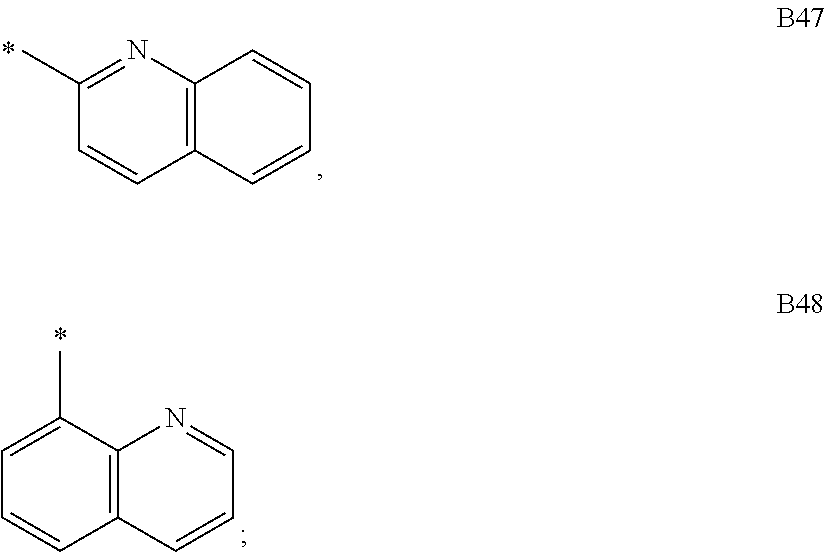
C00018
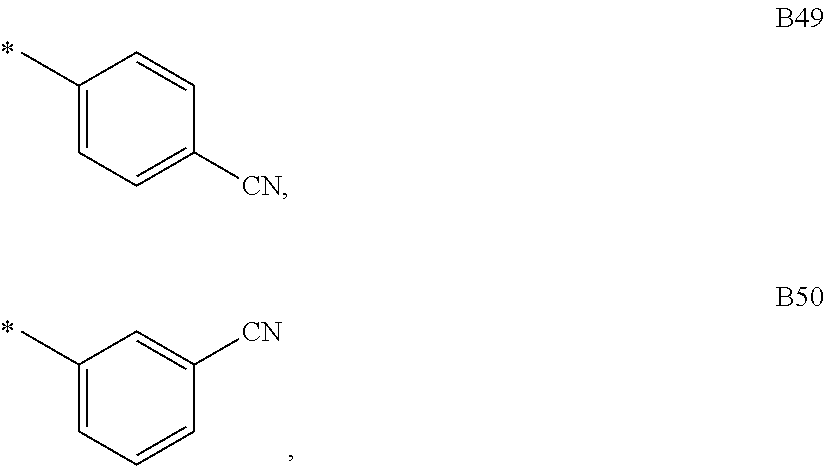
C00019
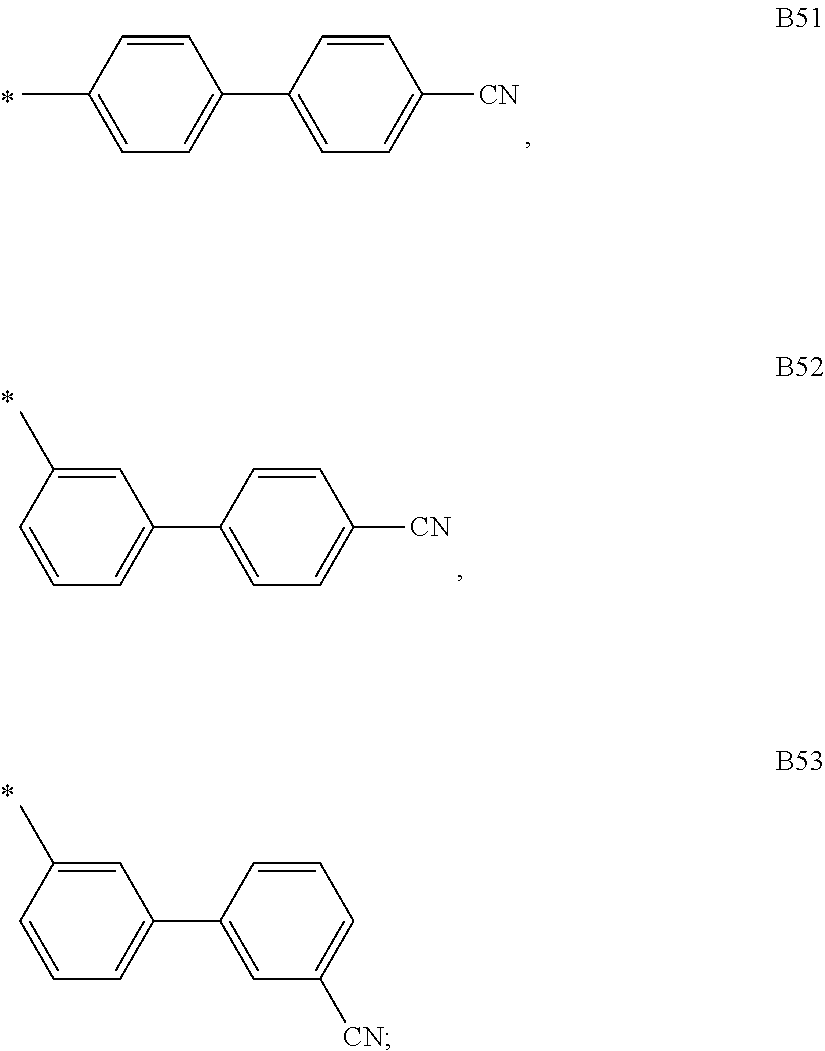
C00020
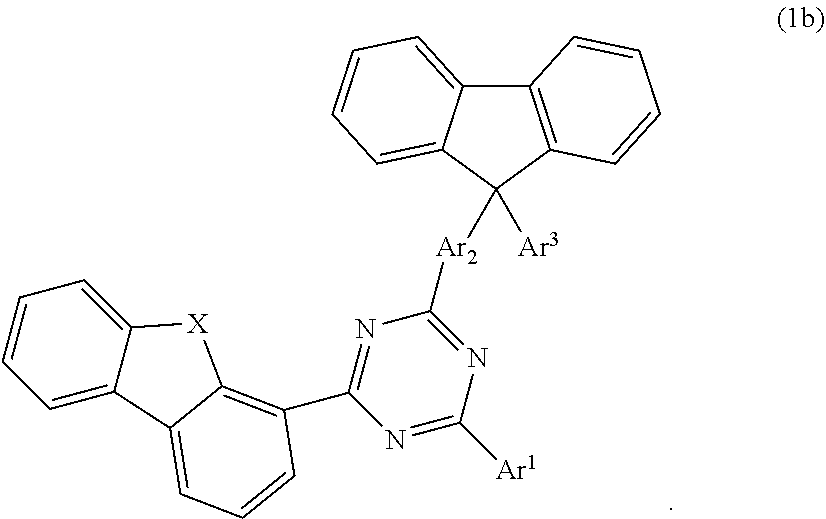
C00021
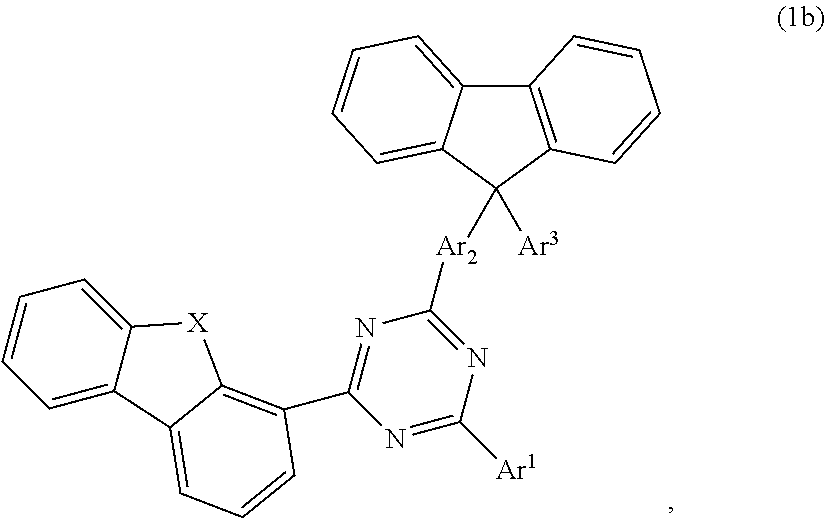
C00022

C00023

C00024
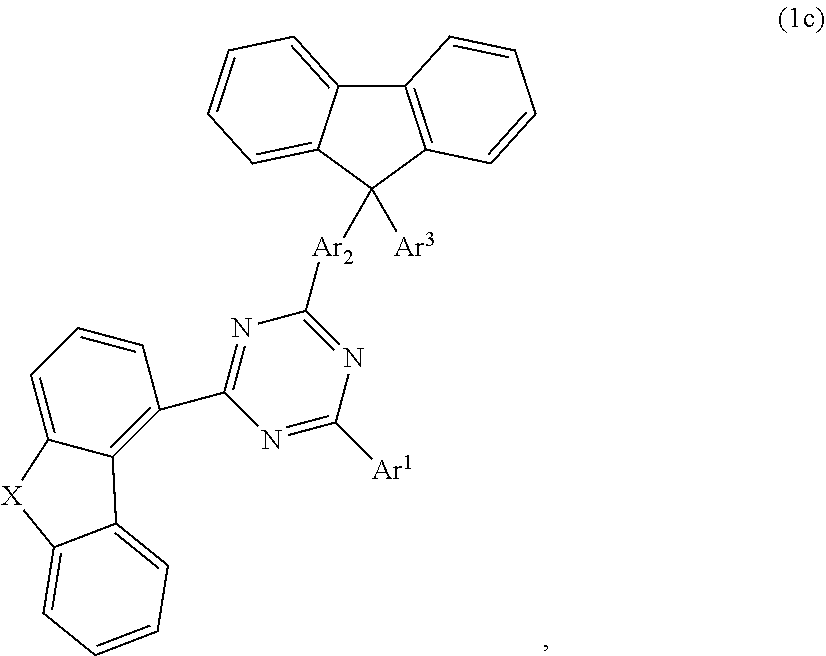
C00025

C00026

C00027

C00028

C00029

C00030

C00031

C00032
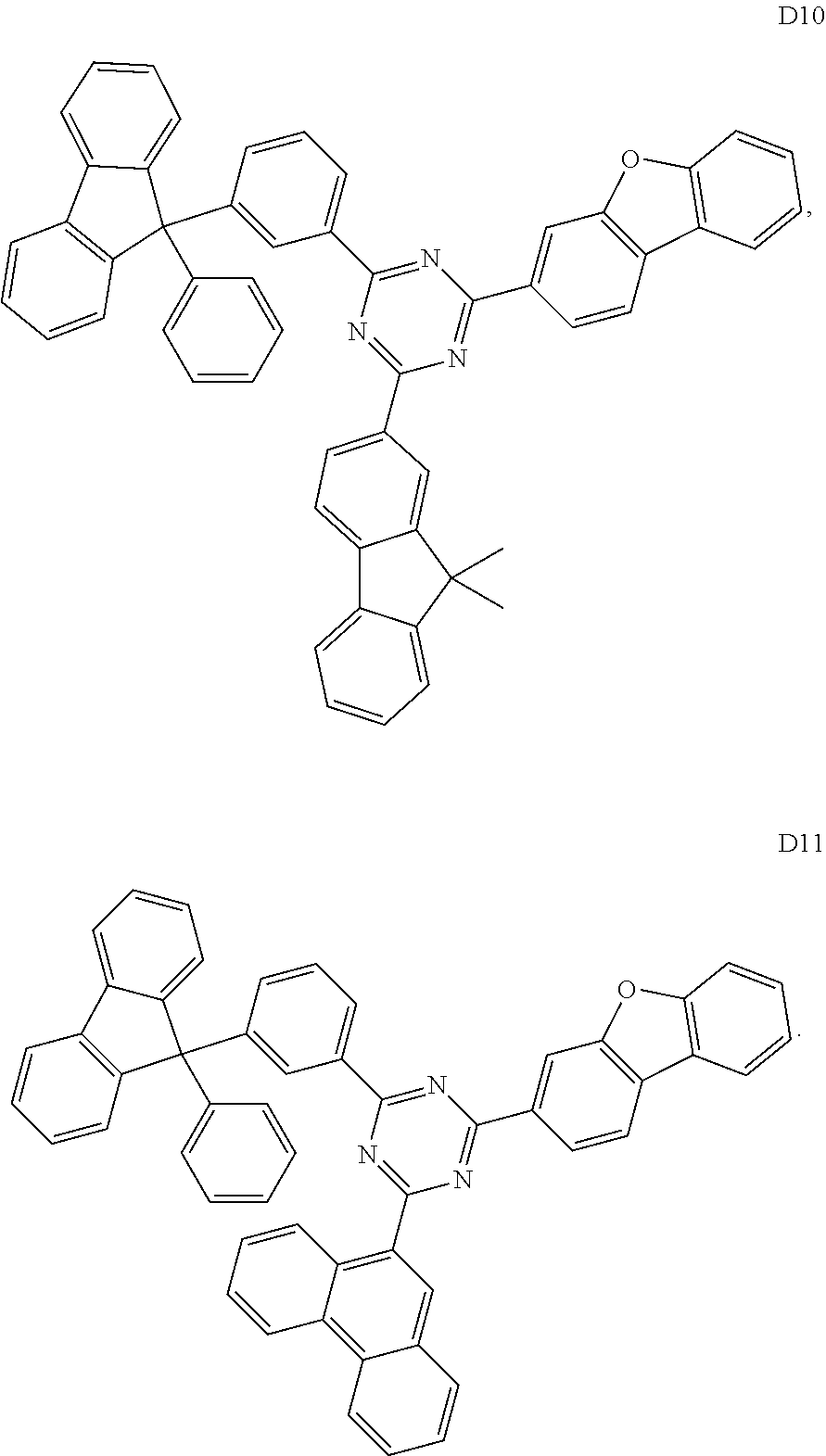
C00033
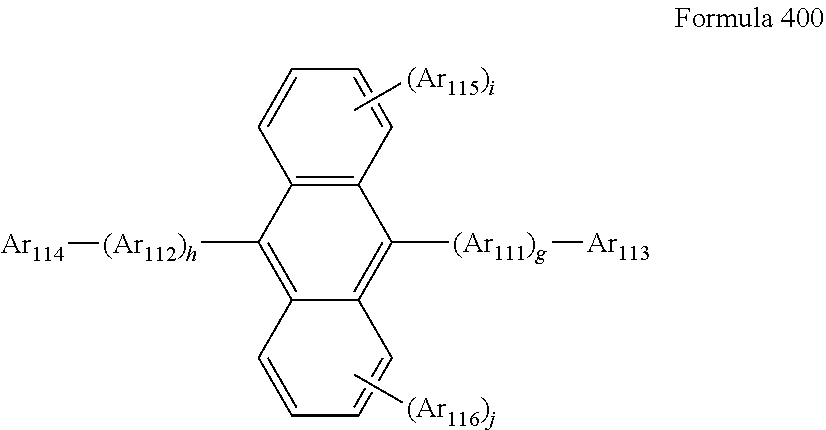
C00034

C00035
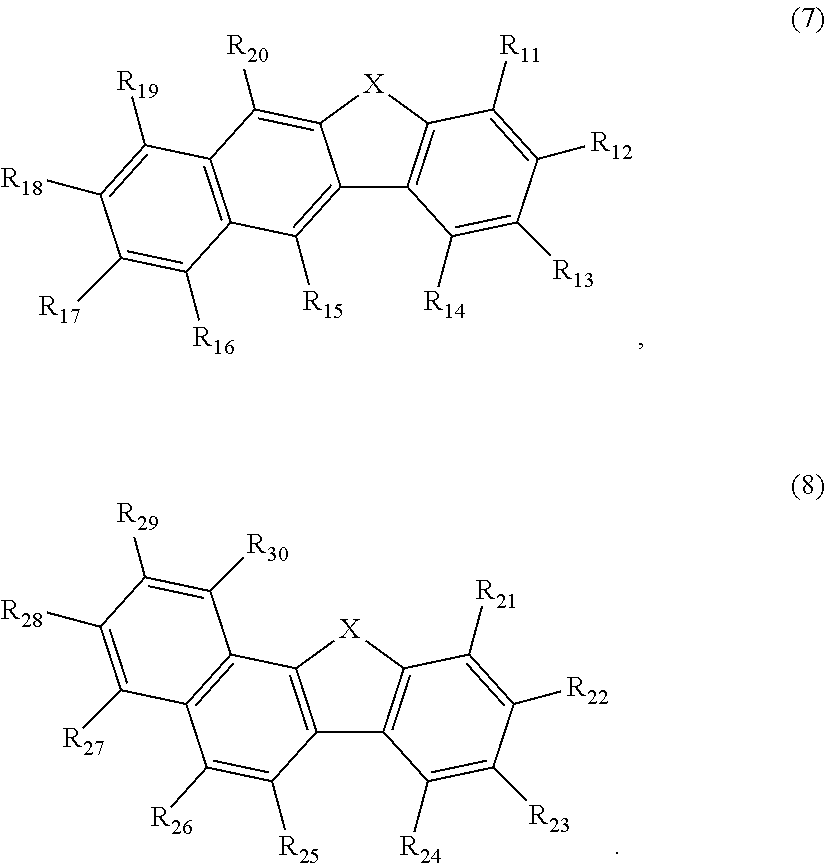
C00036
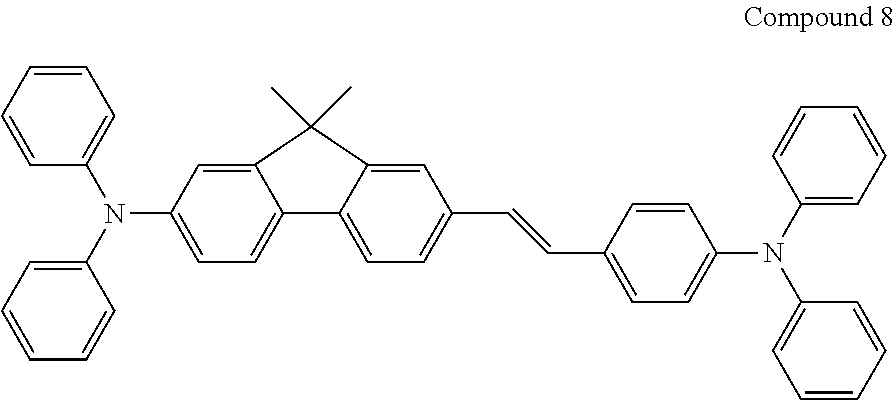
C00037

C00038
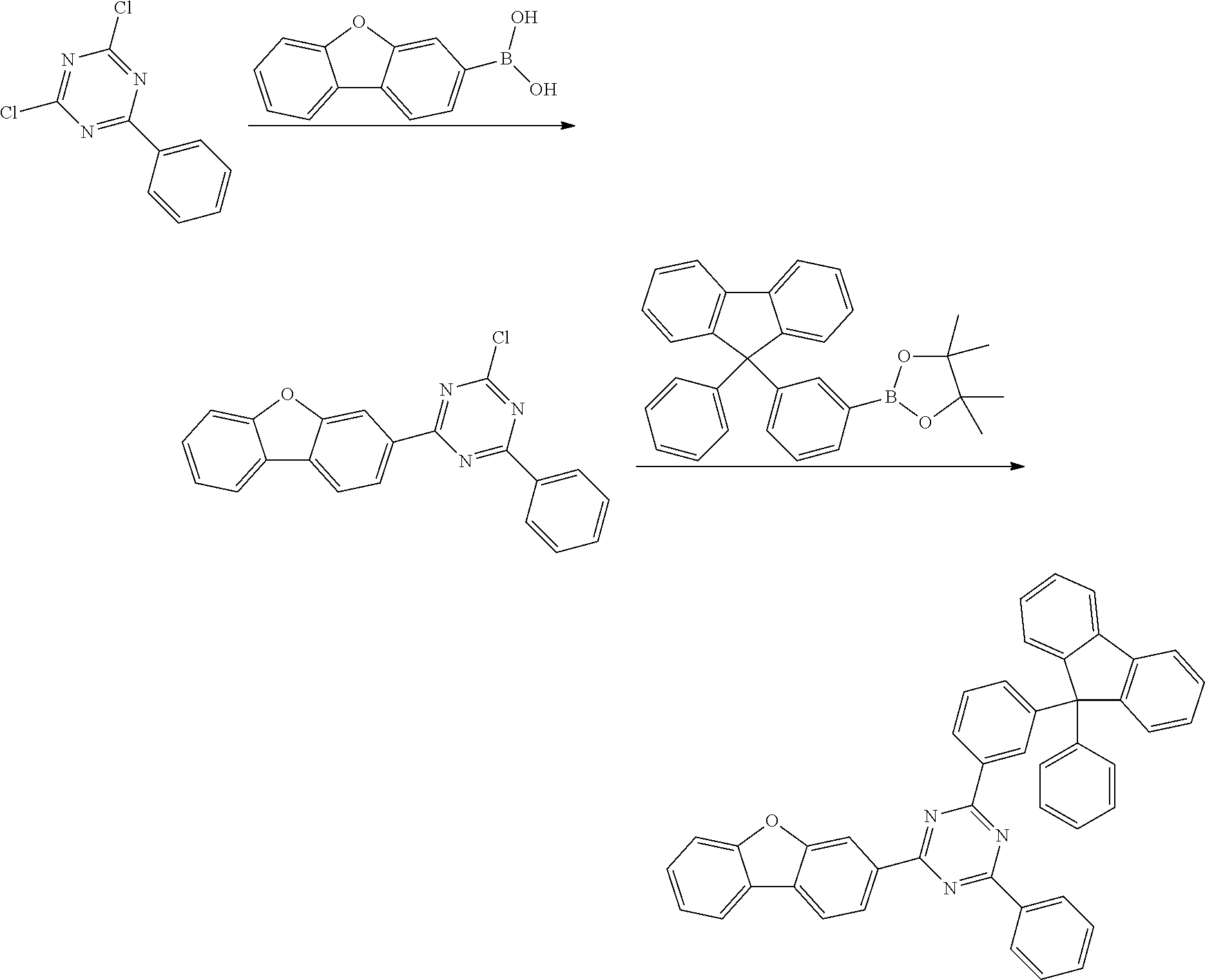
C00039
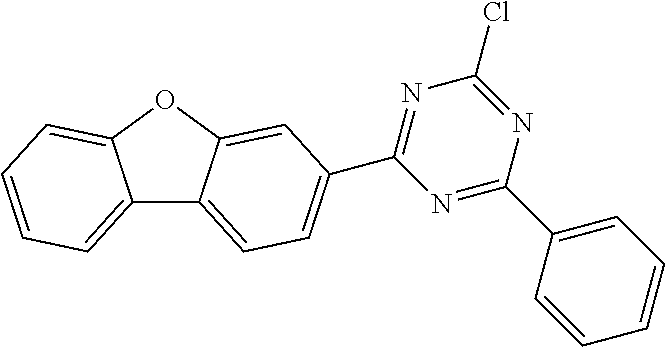
C00040
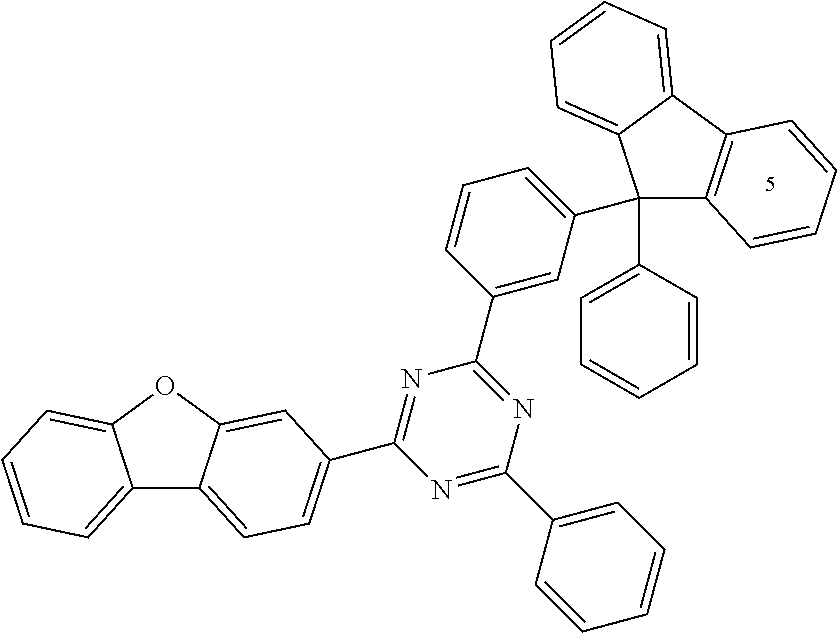
C00041

C00042

C00043
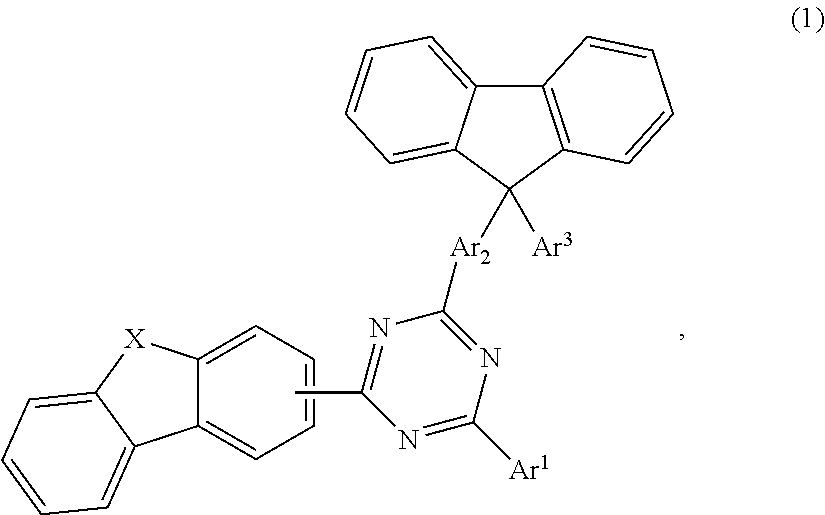
C00044
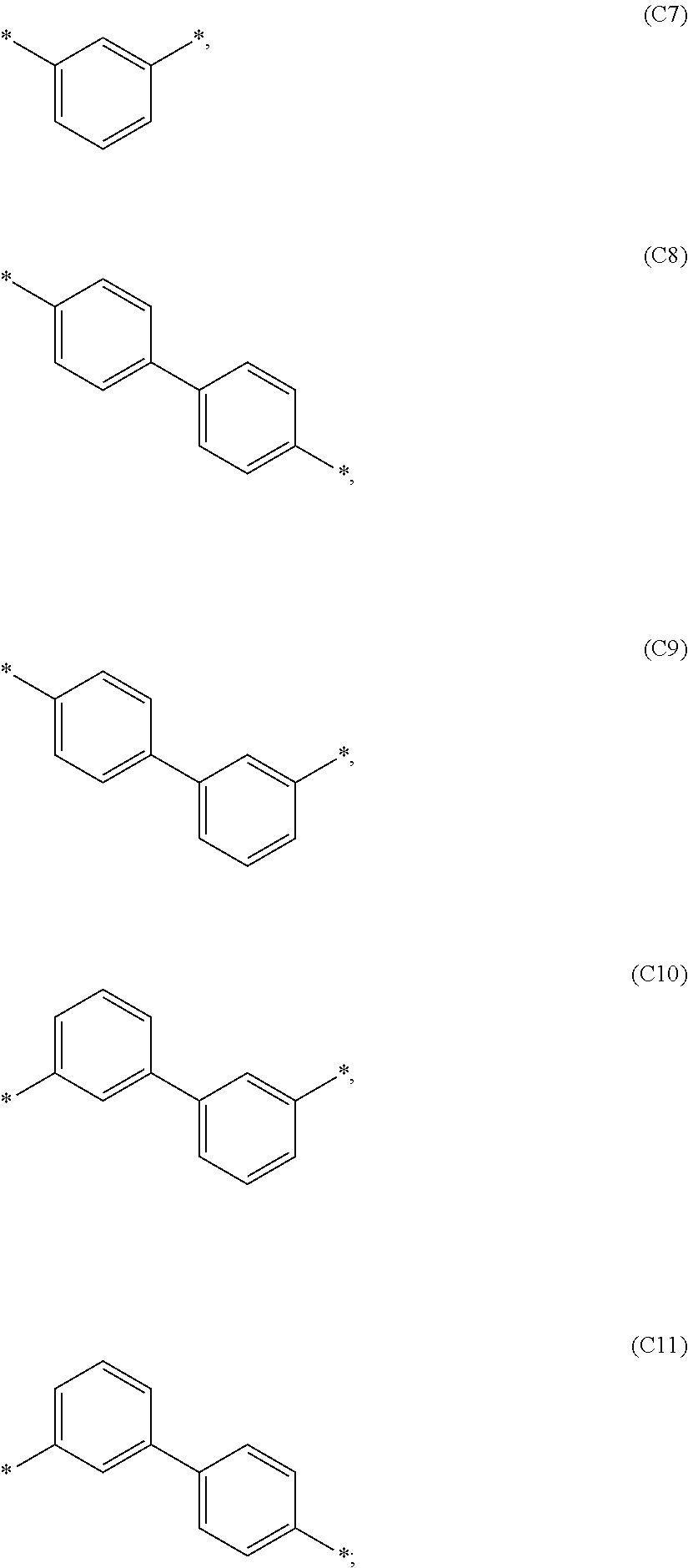
C00045

C00046

C00047
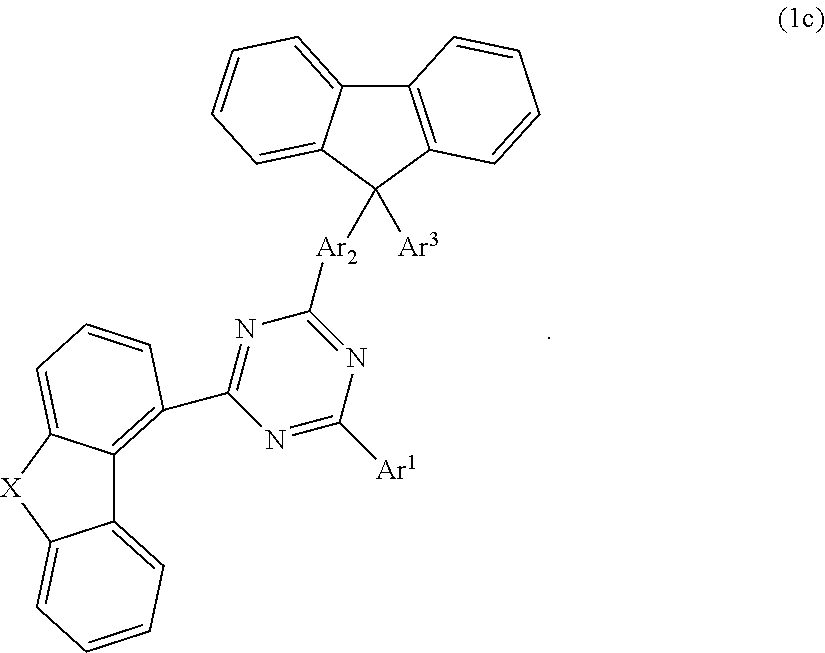
C00048
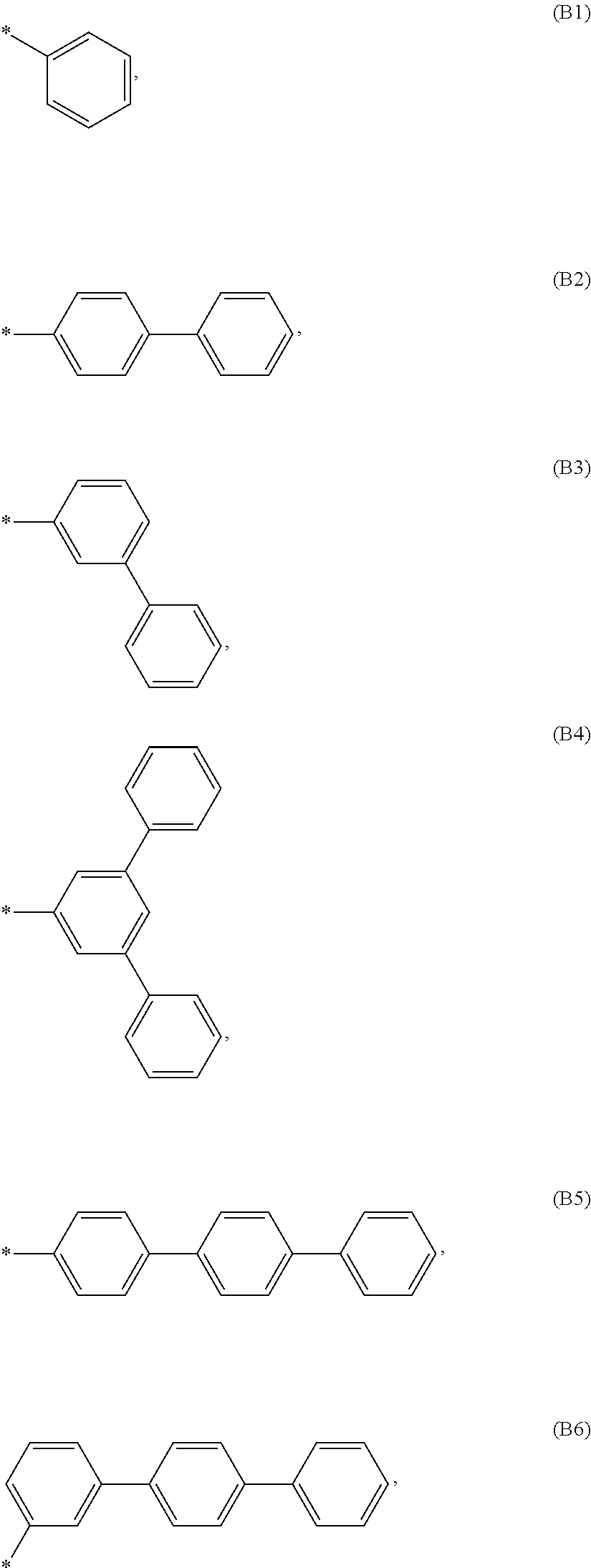
C00049

C00050

C00051

C00052

C00053

C00054

C00055

C00056

C00057

C00058

C00059
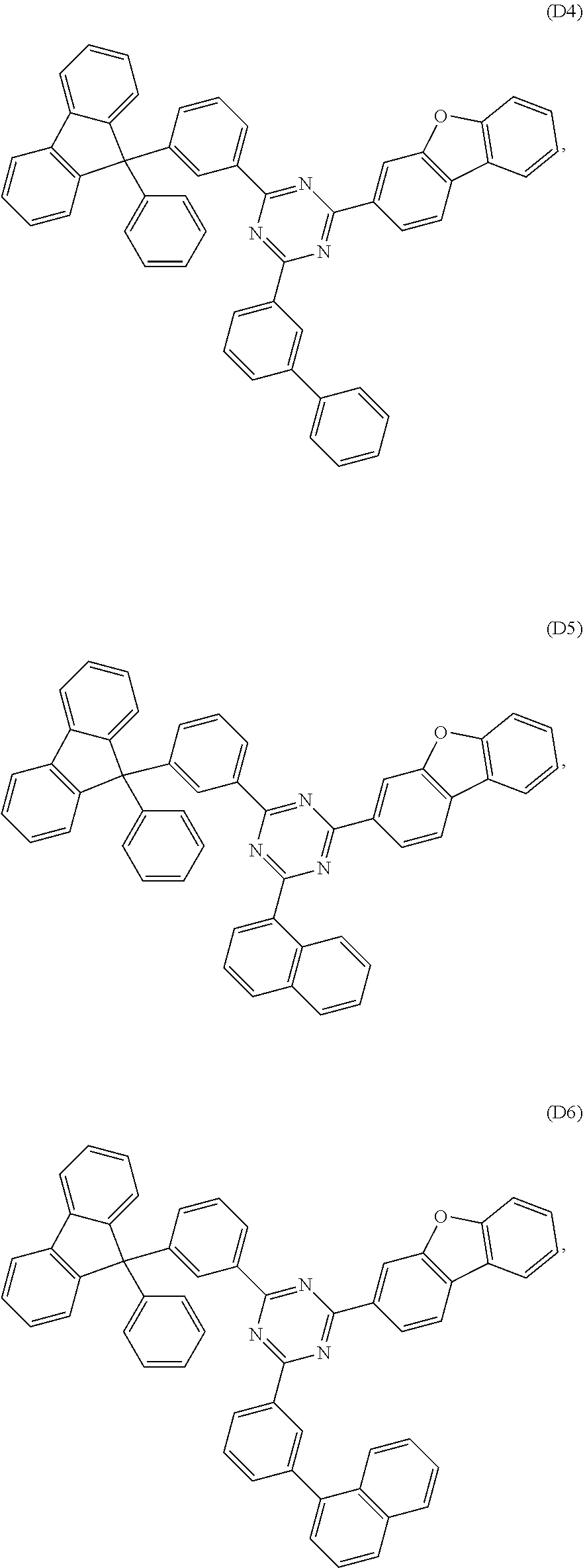
C00060

C00061

D00001
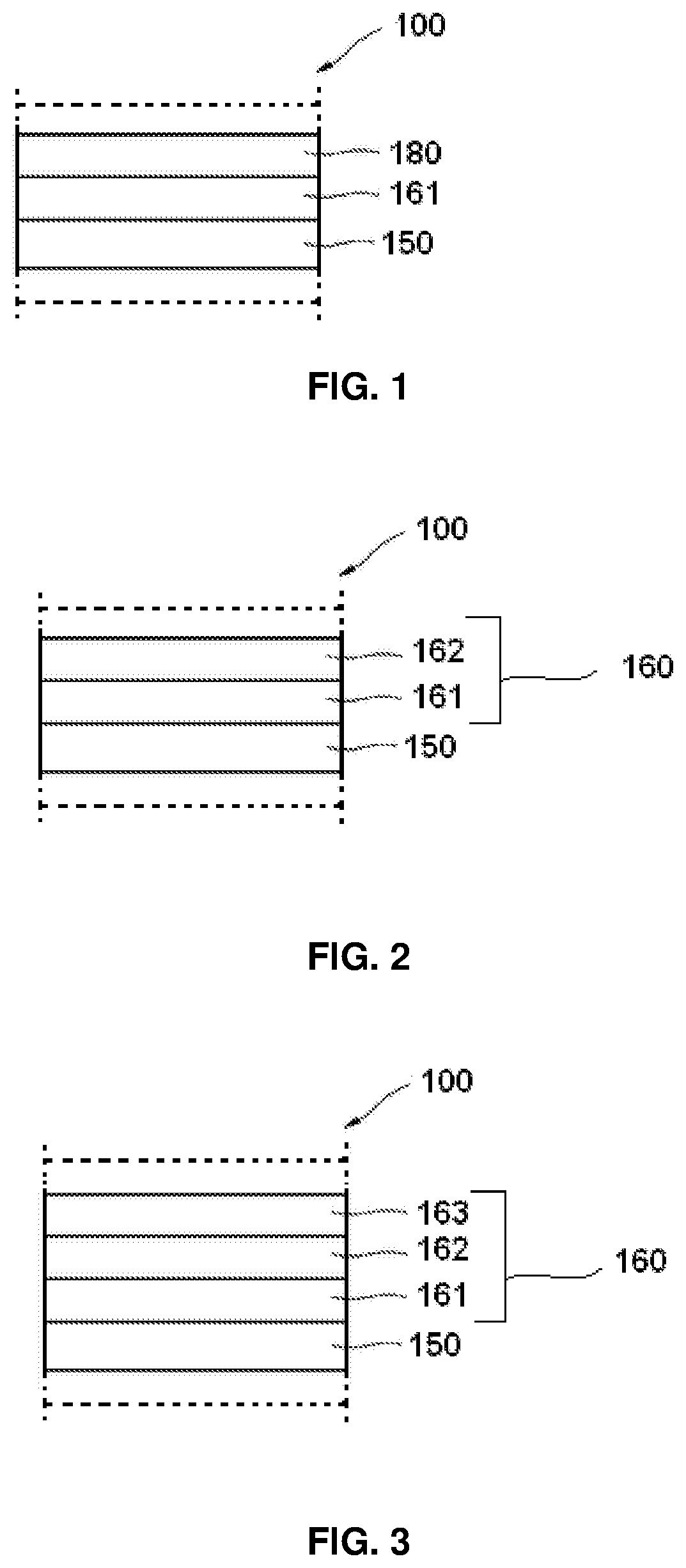
D00002

XML
uspto.report is an independent third-party trademark research tool that is not affiliated, endorsed, or sponsored by the United States Patent and Trademark Office (USPTO) or any other governmental organization. The information provided by uspto.report is based on publicly available data at the time of writing and is intended for informational purposes only.
While we strive to provide accurate and up-to-date information, we do not guarantee the accuracy, completeness, reliability, or suitability of the information displayed on this site. The use of this site is at your own risk. Any reliance you place on such information is therefore strictly at your own risk.
All official trademark data, including owner information, should be verified by visiting the official USPTO website at www.uspto.gov. This site is not intended to replace professional legal advice and should not be used as a substitute for consulting with a legal professional who is knowledgeable about trademark law.